PDF VERSION
HTML VERSION

Original reporting on
leading-edge energy
research and technologies
July 10, 2008 -- Issue #29
Copyright 2008 New Energy Times (tm)
Published by the New Energy Institute Inc. six times per year
Staff
Editor and Publisher: Steven B. Krivit
Copy Editor: Cindy Goldstein
Web Editor: Sally Robertson
Support Team
Randy Souther
H.P.
Nick Palmer
Contributors
Peter Gluck
Jones Beene
Horace Heffner
N. Yabuuchi
Akito Takahashi
Renato Mor
Adriano Bassignana
New Energy Times (tm)
369-B Third Street, #556
San Rafael, CA 94901
(310) 470-8189
|
New Energy Times (tm) is a project of New Energy Institute, an independent 501(c)(3) nonprofit corporation that provides information and educational services to help bring about the clean-energy revolution.
|
__________________________________________________________________________________
New Energy Institute gratefully acknowledges the generosity and support of our major sponsors:
New York Community Trust
Anonymous
__________________________________________________________________________________
EDITORIALS AND OPINION
1. From the Editor: Cold Fusion—The Value of Keeping an Open Mind
2. Opinion: On the Assumption of E-Mail Privacy
3. To the Editor
4. Correction
NEWS & ANNOUNCEMENTS
5. ICCF-14: International Conference on Condensed Matter Nuclear Science-14, August 10-15
6. Fox Archive Back Online
7. 15th Russian Conference on Cold Nuclear Transmutation and Ball-Lightning
8. From the Archives: 1989 APS Special Sessions on Cold Fusion
ANALYSIS AND PERSPECTIVES
9. Japan's Sputnik? The Arata-Zhang Osaka University LENR Demonstration
10. Under the Hood: The Arata-Zhang Osaka University LENR Demonstration
11. International News Coverage of Arata-Zhang Osaka University Demo
12. Deuterium and Palladium Not Required
13. Piantelli-Focardi Publication and Replication Path
14. BlackLight Power—Yesterday and Today
15. The BlackLight Power Patent Mystery
16. A Great Contributor to the CMNS Field: Hal Fox
17. SCIENCE AND ENERGY NEWS
__________________________________________________________________________________
“If the freedom of speech is taken away then dumb and silent we may be led, like sheep to the slaughter.”
—George Washington, first U.S. president |
__________________________________________________________________________________
EDITORIALS AND OPINION
1. Editorial: Cold Fusion—The Value of Keeping an Open Mind
By Steven B. Krivit
|
As a journalist, I have been investigating the subject often referred to as "cold fusion" for eight years, full time for the last four. I don't have an advanced degree or even a science degree, as some of my critics occasionally like to remind people. Most of the veterans of this field, however, have decades of experience in science, many of them approaching 30 or 40 years.
I follow somewhat, but not exactly, in the footsteps of Gene Mallove, founder of Infinite Energy magazine and New Energy Foundation, although he earned multiple science degrees and was at one time the chief science writer with the MIT News office.
"Cold fusion" researchers have struggled and continue to struggle with a scientific inquiry that seems important, necessary, and largely benevolent.
|
These researchers have faced opposition that was highly unscientific, and to lesser degree still is. I feel honored and privileged to seek the truths in the field of condensed matter nuclear science and report them. I, and New Energy Times, help the public and the general scientific community to understand low-energy nuclear reaction research, its facts and myths, and to distinguish between the two.
One particular myth is overdue for review. The myth is that "cold fusion" experiments have empirically demonstrated 23.8 (or 24) MeV of energy per helium-4 atom formation.
In the few years before Mallove’s murder - the result of a crushed trachea and a brutal beating with a blunt instrument – he began to question this myth.
Here are a few examples of the myth’s surfacing:
Julian Brown, "cold fusion" theorist with Clarendon Laboratory, Oxford University, wrote in an e-mail last year, "Haven't the [ENEA] Frascati people demonstrated a quantitatively correct correlation of exothermy with He4 yield? In fact, it was this result that turned me into a cold-fusion believer, and I suspect the same is true of many other people as well."
Bob Smith, one of the conference volunteers for ICCF-14, the 14th International Conference on Condensed Matter Nuclear Science, when asked why transmutation research was not listed (it was added later, in response to inquiries) as part of the official conference scope, responded, "As far as why [the conference organizers] want to keep it to the [Martin Fleischmann-Stanley Pons] effect, my opinion is that they want to minimize the competing effects of getting excess heat and turning it into power. This is the main reason for [focusing on] the Fleischmann-Pons effect: the 23.8 MeV that is produced from the 'fusion' of deuterium."
The Web site for ICCF-14 states the 23.8 MeV assumption as fact: "Associated with this heat in many experiments is the production of helium-4 at levels that account for the heat, if each atom of helium is associated with about 24 million electron volts of energy."
It has taken me four years to see this as the myth that it is.
When I wrote my first paper on this subject, “The 2004 Cold Fusion Report,” I asked Mallove to review and critique it.
He vehemently disagreed with this sentence: "It is now known that that the amounts of excess heat in cold fusion are consistent with the change in energy that results when heavy hydrogen is converted into helium-4."
In other words, I was saying that it was fact that excess heat was now measured at 23.8 MeV per helium-4 atom produced. As I now know, I was inadvertently reinforcing the myth based on what I was told by some CMNS researchers.
Mallove did not mince words with me.
"You're on VERY thin ice is stating that," he wrote. "There is only ONE experiment in which such a fact has been even approximately proved, and that is the SRI International reproduction of the Case catalytic fusion work. Instead of saying consistent say correlated to some degree with." [Emphasis original]
I see in my notes that I "rejected" Mallove's critique after asking a prominent CMNS researcher, Edmund Storms, formerly of Los Alamos National Laboratory for comment. Mallove was wrong, according to Storms; he said that researchers at the U.S. Navy China Lake laboratory and an Italian government laboratory all quantitatively measured helium-4 that proved a 23.8 MeV reaction, because they all "quantitatively measure helium-4 within a factor of two."
I considered Storms more of a first-hand source than Mallove, and Storm's viewpoint had consensus among other CMNS researchers, so I went along with his suggestion to disregard Mallove’s critique.
So why and how did my view shift? It started with a conversation I had with theoretical physicist Scott Chubb, with the Naval Research Laboratory in Washington, D.C., in response to the Widom-Larsen not-fusion theory.
Chubb said that the Widom-Larsen theory was wrong because "McKubre reported finding the 23.8 [MeV which was reported in] the Department of Energy white paper."
In the following months, I kept Chubb's comment in the back of my mind. On a fluke, I opened Mallove’s e-mail from 2004 recently and found his comment about "thin ice." To my surprise, I had more or less independently arrived at the same viewpoint.
I regretted that I had dismissed Mallove’s critique. I began to dig and found that he had been public with his dissent regarding the claims of 23.8 MeV in "cold fusion." These appear in his paper from the 10th International Conference on Condensed Matter Nuclear Science.
"The primary theorists in the field," Mallove wrote, "have generally assumed that the excess heat phenomena is [quantitatively] commensurate with nuclear ash (such as helium), whether already identified or presumed to be present but not yet found. That was an excellent initial hypothesis. However, the commensurate nuclear ash hypothesis has not been proved, and appears to be approximately correct in only a few experiments."
In other words, he was saying that the so-called proof of "fusion" was an assumption, that the primary theorists had assumed that the hard evidence for "fusion" existed somewhere within the available data, or they assumed it would, at some time, be uncovered. This would be, naturally, the proof of the hypothetical reaction process D+D>4He + 23.8 MeV heat (lattice) and, of course, no gamma.
Let's look at what the data actually say.
| | MeV per Helium-4 Atom |
Michael McKubre (SRI International) |
31, 38.34, 34.45, 22.85 |
Melvin Miles (U.S. Navy - China Lake) | 39, 25, 44, 88, 83, 52, 62 |
Antonella De Ninno (ENEA Frascati) |
103, 88, 124, 103, 103 |
McKubre and Miles have confirmed these values; I have been in communication with De Ninno up until press time.
Each of the values, of course, has associated error bars. McKubre's 22.85 MeV, for example, has a range of 20.56 to 25.13 MeV. His value of 31 MeV has a range of 18 to 44 MeV. The sources for this data are this spreadsheet and the hyperlinked papers within it.
Readers will note that 23.8 MeV was not reported by any of these researchers.
According to McKubre, no more than six studies show a quantitative correlation of excess heat to helium-4. He said that his data are the closest matches to the hoped-for 23.8 MeV and that the others are within a factor of two of 23.8 MeV. On the other hand, the temporal correlation between excess heat and helium-4 is, in my opinion, rigorous.
For readers who still wonder what the big deal is among 23.8, 22.8 and 31, perhaps some theoretical nuclear physics will help. When two deuterons undergo thermonuclear fusion, and if by chance follow the reaction path that produces helium-4, 23.8 MeV of energy will be released per atom of helium-4 produced as a result of the mass difference between the pair of deuterons and the helium-4.
Well, so what? readers may ask. All of the data measured by the three groups listed here are well within the energy range of a nuclear phenomena. All of these experiments showed consistent signatures of a new form of environmentally clean, or green, nuclear energy.
The "so what" is that, if the hoped-for value is not shown to be 23.8 MeV, then there is no "proof" that the process of "cold fusion" is, in fact, fusion. The implication is that some other "hitherto-unknown nuclear process," as Fleischmann and Pons wrote in 1989, may be responsible for the observed anomalous energy and nuclear products and effects.
I suppose Mallove and Storms were both correct, from their own perspectives. Perhaps the empirical data will show 23.8 MeV. Perhaps not.
Miles' group was the first to find an excess heat and helium-4 correlation. That experiment took place 14 years ago. McKubre's group reported the closest match so far. That experiment took place 13 years ago. De Ninno's group completed that work six years ago.
For now, I'll take Mallove's advice: LENR experiments show a high degree of temporal correlation between the production of excess heat and helium-4. LENR experiments show some degree, within an order of magnitude, of a quantitative correlation that is consistent with the claim of a fusion process releasing 23.8 MeV energy per helium-4 atom formed and is consistent with other nonfusion theoretical models.
Nonfusion models discussing neutron formation/processes have been around for years, beginning with Yasuhiro Iwamura, Tadahiko Mizuno, John Fisher, Allan Widom and Lewis Larsen, and, more recently, Stan Szpak (See also).
__________________________________________________________________________________
2. Opinion: On the Assumption of E-Mail Privacy
BACKGROUND:
Nobel Prize winner Brian Josephson had sent e-mails to Steven B. Krivit, the editor of New Energy Times and an investigative journalist who specializes in LENR research. The e-mails were about Russ George's activities in the LENR field.
Josephson had invited George to give a lecture at Cambridge University on Oct. 21, 2005, about his company, D2Fusion. George had been offering to sell shares of stock. Josephson wrote that D2Fusion was going to be selling 1-kilowatt fusion-powered heaters commercially within a few months.
Josephson wrote to Krivit, "I might invest a little in shares" in George's company. On Dec. 16, 2005, in an e-mail to Krivit, Josephson wrote that he thought "$1 could turn rapidly into
$10" and
asked Krivit for advice. Josephson made no request for privacy in the letter and there was no agreement between them that messages were to be off the record.
A month earlier, Krivit had heard that the best results obtained by scientists working for George were not 1,000 watts but 1/4 of a watt. Instead of giving advice to Josephson, Krivit began a news investigation into the highly unlikely claims.
When the New Energy Times investigation published, Josephson defended George and initiated a smear campaign against Krivit. Josephson later wrote that he thought his Dec. 16, 2005, letter about investing in D2Fusion had offered "good advice for Krivit."
[Below is an edited version of a letter from LENR fan Horace Heffner that was originally published to the Condensed Matter Nuclear Science an Internet discussion list, and the author has granted permission for his letter to be published outside of the list. The letter was posted in a thread initiated by Josephson in which Josephson complained about publication of his e-mails to journalist Krivit and to the CMNS internet discussion list.]
By Horace Heffner
It strikes me as somewhere between audacity and hubris to expect to inhibit a person's rights by the unilateral action or demand of the sender of an e-mail or snail mail.
No unsolicited correspondence, especially between parties without an established relationship, should be capable of inhibiting the rights of anyone. It is at best extremely bad manners to not establish a relationship in which privacy might be expected before sending such a request along with the information deemed to be private.
This kind of unilateral act of sending privileged or private information with the expectation of its being kept secret amounts to an attempt to establish a fully one-sided contract. It also assumes the recipient does not have or have access to subject information.
Frequently, the purpose of such correspondence is to silence the recipient or to cloud his or her intellectual property rights. In other words, correspondence that includes unilateral assertions that "this is confidential," "this is secret," or "this
is a trade secret" is intended to prevent the recipient from publicly discussing things which he or she is otherwise free to discuss publicly and regarding which he or she may independently have or have access to.
The expectation of privacy, or the scope of privacy, of communication should be earned through established relationships. The greater the importance of the privacy, the greater the need for prior formal or at least concrete agreement.
I was initially surprised that, when I placed some of my most creative ideas into the public domain by posting them, I would shortly get private e-mail that starts out "this is a private communication. ... Keep this secret," "We have also worked on this a long time. ... blah blah blah."
I get the impression that the primary purpose of such communication is to shut me up on a particular subject, and of course I tend to resist this kind of intimidation immediately.
I've also seen the results of the other kind of intimidating private correspondence, the directly threatening kind, directed at one or more members of a news list for the purpose of shutting them up, and I think the best approach to threatening communications is to post them as soon as possible so everyone knows what is happening and who is doing what to whom.
It is possibly true or even likely that none of the above has anything to do directly with the issues at hand in this specific case in this CMNS list. However, basic manners and even a respect for rights certainly have a place in this discussion.
So who is the aggressor? The sender of unsolicited and intimidating demands, or the person receiving them out of the blue? It is at best audacious to expect confidentiality for an unsolicited, and even unexpected, communication. A reasonable remedy for unilateral attempts to restrain rights to free communication seems to me clear, and that is the right to make the associated communication public, though this and related topics are likely future issues for the highest courts.
__________________________________________________________________________________
3. To the Editor
To the editor:
[Editor's note: This letter is in response to a New York Times article entitled "Heard the One About the Farmer's Ethanol?" cited in the "Science & Energy News" section of New Energy Times Issue #28, published on May 10, 2008.]
On Page 22 of your recent New Energy Times, you are talking about wind and solar power and the drawbacks being intermittent.
Let me say here that all the sources of energy, apart from those which come from billions of years ago—that is, oil—are intermittent. Even tidal energies are varied, though here you do know a bit more about what's going to happen, but the major thing to understand in respect to wind and solar is that you have to put them in a medium.
It's no use thinking you can use wind or solar apart from the question of intermittency without converting the energy to something. It's been converted to electricity for many decades, perhaps for 100 years, and in quite a few cases, that's enough. But you can't store large amounts of electricity, and you can store large amounts of hydrogen.
So as far as I can see, there is no other way but turning it back to hydrogen, storing that at, say, 100 Atmospheres, then sending that off to wherever you want so that your Chicago buses at 10 p.m. in the winter evening can run on hydrogen which was made by wind energy three days back.
But you do have to realize that such storage has to be done; otherwise, you can't use wind and solar sources, and of course, they are the sources, not the hydrogen.
John O'M. Bockris
Gainesville, Florida
(Letters may be sent to "letters" at the New Energy Times domain name. Please include your name, city, and state or province.)
__________________________________________________________________________________
4. Correction
In the May 10 issue of New Energy Times, a letter to the editor by Albert Alberts stated "Fusion of deuterium into helium-4 gives a yield of 17 MeV." That, however, is the value for a deuterium-tritium reaction. Fusion of deuterium-deuterium yields 23.8 MeV.
__________________________________________________________________________________
NEWS & ANNOUNCEMENTS
5. ICCF-14: International Conference on Condensed Matter Nuclear Science-14, August 10-15, Washington, D.C.
This weeklong conference, to be held in Washington, D.C., in August, focuses entirely on low-energy nuclear reactions, part of the field of condensed matter nuclear science, historically known as "cold fusion."
David J. Nagel, research professor with George Washington University, is the general chairman, and Michael E. Melich, affiliated with the Naval Postgraduate School, is the co-chairman. The official conference Web site is http://www.iccf-14.org/.
Conference organizers mention numerous problems with the terminology of the field. Specifically, they cite problems with the term "condensed matter nuclear science," which was adopted in May 2002 at the ICCF Advisory Committee meeting in Beijing, China, and has been used for the titles of each of the proceedings since. They cite problems with the term that New Energy Times, LENR-CANR, and American Chemical Society, to name a few, now use to identify the experiments: low-energy nuclear reactions.
Conference organizers state that "none of these names has gained universal acceptance"; they suggest instead that the new name for the field and the experiments should be the "Fleischmann-Pons Effect." The ICCF-14 terminology is consistent with terminology used by Michael Melich in his earlier review papers of the field but is inconsistent with terminology Nagel has presented in the last few years.
In October 2006, Nagel used the term "Low-Energy Nuclear Reactions" to describe - as he suggested - the two separate groups of reactions seen in the field. He titled the first "Cold Fusion," referring to processes involving light elements such as deuterium and helium. The second group involved reactions with "elements across the periodic table" - in other words, heavy-element transmutation.
At the National Defense Industrial Association Naval Science and Technology Partnership Conference on Aug. 2, 2006, Nagel explained that "LENR can involve elements across the periodic table" and that "the field of research on LENR is now called condensed matter nuclear science."
After significant thought and discussion with Nagel and other leaders in the field several years ago, New Energy Times arrived at a perspective similar to Nagel’s in 2006; the field of research on LENR is now called condensed matter nuclear science.
For helpful information on this terminology, please see the New Energy Times FAQ #9: What does the terminology Low-Energy Nuclear Reactions (LENR) and Condensed Matter Nuclear Science (CMNS) mean?
__________________________________________________________________________________
6. Fox Archive Back Online
New Energy Times took the Hal Fox Fusion Information Center Archive offline on May 30 in order to resolve some confusion about copyright issues. The archive is back online. Hal Fox is one of the early journalists and publishers who covered the subject of "cold fusion."
New Energy Times is grateful to Hal Fox for his permission to make these historic archives available publicly and to William Collis, founder of the International Society for Condensed Matter Nuclear Science, for his efforts to convert this archive to HTML. Copies of this archive on DVD-ROM can be purchased from the ISCMNS Web site.
__________________________________________________________________________________
7. 15th Russian Conference on Cold Nuclear Transmutation and Ball-Lightning
The 15th Russian Conference on Cold Nuclear Transmutation and Ball-Lightning (RCCNT&BL-15) will take place 1-8 October, 2008, at the Dagomys Hotel in Sochi, Russia.
The conference program includes the following subjects:
* Experimental research in cold nuclear transmutation and ball lightning
* Theoretical models with respect to Cold Nuclear Transmutation
* Application of ball-lightning effects to devices
More information
__________________________________________________________________________________
8. From the Archives: 1989 APS Special Sessions on Cold Fusion
What really happened on May 1 and 2, 1989, at the American Physical Society Special Sessions on Cold Fusion in Baltimore, MD?
New Energy Times continues to peel back the layers of the scientific controversy of the century to understand more precisely this crucial turning point in the cold fusion story.
We are pleased to provide, for the public record, reproductions of the official APS press release and the abstracts of the talks submitted for the Special Session on Cold Fusion.
Abstracts
APS Press Release
__________________________________________________________________________________
ANALYSIS AND PERSPECTIVES
9. Japan's Sputnik? The Arata-Zhang Osaka University LENR Demonstration
By Steven B. Krivit
[A more technical article, "Under the Hood: The Arata-Zhang Osaka University LENR Demonstration," follows this article in this issue of New Energy Times.]
Year after year, New Energy Times readers have asked us, "When will we finally see something demonstrable, a light bulb or a motor running from a LENR experiment?"
Perhaps the wait is over.
On May 22, professor emeritus Yoshiaki Arata (Osaka University) and professor Yue Chang Zhang (Shianghai Jiotong University) did it. With the flick of a finger to start the Stirling engine, they saw the heat from their LENR experiment—with no applied electrical energy—turn a small rotor for many minutes. The presumption is that the motor was turning during the nuclear energy production phase rather than the chemical energy production phase.
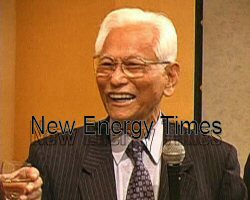
Yoshiaki Arata receiving Preparata
Award in 2007
Photo: S.B. Krivit |
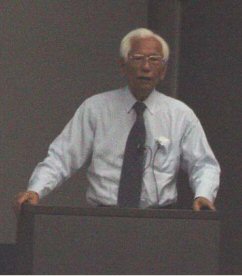
Professor Arata giving lecture
Photo: A. Takahashi |
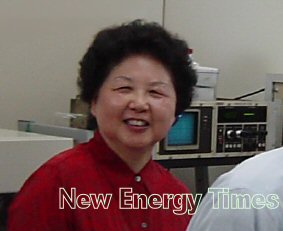
Professor Zhang in laboratory
Photo: A. Takahashi |
Arata is a highly respected physicist in Japan who has been the recipient of Japan's highest award, the Order of Cultural Merit, and is the first person to have performed a thermonuclear fusion experiment showing large amounts of deuterium-deuterium reactions in Japan.
However, after more than half a century, thermonuclear fusion research has yet to produce a single experiment that demonstrates any energy release beyond that which it consumes.
Arata and Zhang are not the first to perform a live public demonstration of LENR excess heat, a possible new source of clean nuclear energy, but they are the first to display publicly a LENR application that is visible.
The demonstration took place on Arata's 85th birthday at the Osaka University Advanced Science and Innovation Center. A lecture by Arata at Arata Hall of the Joining and Welding Research Institute (named his honor) on the Suita campus of Osaka University preceded the demonstration, and a question-and-answer session followed the demo.
Norio Yabuuchi, of the High Scientific Research Laboratory of Tsu City, Mie, Japan, provided New Energy Times with a video recording of the public demonstration. A short segment that shows the motor in action is here.
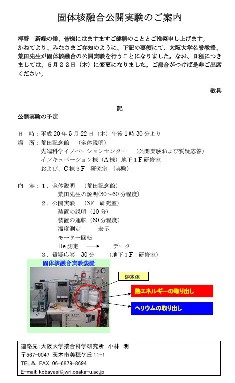
Announcement of Lecture and Demo
(Click for larger image)
|
|
The full, unedited video, as provided to New Energy Times, broken into three segments, is now online. (The video is not a professional production, and New Energy Times apologizes for the quality of the video, though we are grateful to have the only publicly available copy at this moment.)
- Arata Lecture (44 minutes)
- Laboratory Demonstration (31 minutes. Please note there is a 3 minute segment when the focus of the video camera wanders; please be patient.)
- Question-and-Answer Session (16 minutes)
Members of the Osaka team include researcher Wang Xiaofeng and technicians Ohmura and Urasaki.
Professor Akito Takahashi of Osaka University witnessed the demonstration. Takahashi wrote that 60 people from universities and companies in Japan and a few people from other countries attended, as well as representatives from six major newspapers and two television stations. Some of the international print media coverage is listed in a separate item in this issue of New Energy Times under "International News Coverage of 2008 Arata-Zhang Demonstration."
Jed Rothwell, librarian of the LENR-CANR.org Web site, was, according to Takahashi, the only American present at the lecture and demonstration.
|
"The high operating temperature, instant response and reliability of this device make it the most practical form of LENR yet developed," Rothwell wrote. "The small amount of palladium is also a major advantage. As far as I know, all of the tests with Zr-Pd targets and D2 have produced heat immediately and predictably. It may not be possible to turn off the reaction instantly, but this is no impediment to practical applications; it is not possible to turn off the heat from burning coal or uranium fission, either."
Evidence for the claim of a nuclear reaction came from the quadrupole mass spectrometry measurements of helium produced by the experiment. According to Arata, no helium was present in any of the materials before the experiment, and no helium was introduced from the atmosphere.
Arata states that no input energy is required for the experiment, aside from the energy required to create the initial vacuum and gas pressure and to bake the powder to remove impurities.
In an earlier conversation with New Energy Times, Arata offered his perspective on LENR research.
"Some people say we have reached the end of science, that there are no more great discoveries that remain. In my view, nature always has more secrets to reveal," Arata wrote. "I always stay on guard not to be too possessed by my own current knowledge. History has shown us repeatedly, for example, the foolishness of denying 'heliocentricism,' which resulted from individuals adhering too strongly to their own knowledge or to what was common sense in the past."
__________________________________________________________________________________
10. Under the Hood: The Arata-Zhang Osaka University LENR Demonstration
By Steven B. Krivit
[This is a follow-up article to "Japan's Sputnik? The Arata-Zhang Osaka University LENR Demonstration."]
As New Energy Times reported in "Japan's Sputnik? The Arata-Zhang Osaka University LENR Demonstration," professor emeritus Yoshiaki Arata (Osaka University) and professor Yue Chang Zhang (Shianghai Jiotong University) demonstrated an historic LENR experiment in Osaka University, Japan, on May 22. This article will take a more technical look at the experiment.
Arata and Zhang are not newcomers to low-energy nuclear reaction research. They have been involved in LENR research since the beginning and in related research for decades before that. They have a long history of publications; for example, their March paper lists 52 of their previous papers.[2] Arata does not refer to his work as "cold fusion"; he prefers the term "solid fusion."
In the recent work, Arata-Zhang used two variations of a nanopowder sample, contained within a stainless steel chamber, and they applied deuterium gas at pressures reaching 65 atm. The only source of energy input is the gas pressure. The result is long-lasting anomalous heat production from the cell, as well as the evolution of helium-4, the basis for their claim of a nuclear reaction. According to Arata, no helium was present in any of the materials before the experiment, and no helium was introduced from the atmosphere.
Osaka University professor Akito Takahashi witnessed the demonstration.
"Arata and Zhang demonstrated very successfully the generation of continuous excess energy (heat) from ZrO2-nano-Pd sample powders under D2 gas charging and generation of helium-4," Takahashi wrote. "The demonstrated live data looked just like data they reported in their published papers.[1, 2] This demonstration showed that the method is highly reproducible."
The formulas for the alloys are described in a 2002 paper with Shin-ichi Yamaura. [3]
Data from the live demo is not available; however, our report will refer to published data from similar experiments, as mentioned by Takahashi.
Arata uses novel terms: "Jet-Nuclear Fusion Start," "Jet-Fusion Zone," "Skirt-Fusion Zone," and "Jet-Stream." In e-mail exchanges, New Energy Times asked Arata to clarify the experiments and terminology. Where possible, our article will use common language to explain the mechanics of the experiment. One clarification we received from Arata, with the help of Takahashi, is the derivation of the term "Jet-Stream."
"The deuterium absorption by the nanopowder sample is so strong that it absorbs the deuterium gas input, and this causes the deuterium gas to flow as a jet stream in the initial phase," Takahashi wrote. "When the jet stream stopped - that is, when the nanopowder reached maximum deuterium absorption, hence the end of the chemical heating phase - the gas pressure began to rise."
In the papers and the graphs, at least in the English translation, the use of the term "vessel" is ambiguous because there are two vessels. The inner vessel contains the sample material. This vessel is inside another vessel to provide thermal isolation from the room environment. For clarity, we will describe the inner vessel as the cell and the outer vessel as the thermal isolation chamber. Arata designates the temperature inside the cell Tin and the temperature inside the thermal isolation chamber - between the cell and the room - Ts.
Another clarification New Energy Times received from Arata is that the term "without storing inside" means that all of the D2 gas entered the cell and was absorbed by the nanopowder. Arata stated that it takes about 12 hours to reach the maximum pressure, 65 atm, which then remains constant throughout the duration of the experiment.
With the ZrO2Pd alloy + D2 experiment in Fig. 2 below as an example, which displays time from 0 to 300 minutes, the following steps describe the sequence of events:
- At T=0, researchers bake and cool the vessel to remove impurities in the sample, in this case ZrO2Pd alloy.
- At T=50, Tin and Ts reach equilibrium with each other and with room temperature.
- At T=50, they start the flow of D2 gas into the cell. Pressure does not rise at this time because D2 is absorbed into the nanopowder sample. Both Tin and Ts rise. Tin rises faster and gets hotter because the energy is coming from within the cell.
- At T=68, the pressure inside the vessel automatically begins to rise when the nanopowder reaches its maximum capacity of D2 absorption. The previous temperature rise seen in Tin and Ts halts immediately and rapidly drops.
- At ~T=80 and ~33C, the deceleration of the temperature drop slows dramatically and begins to plateau.
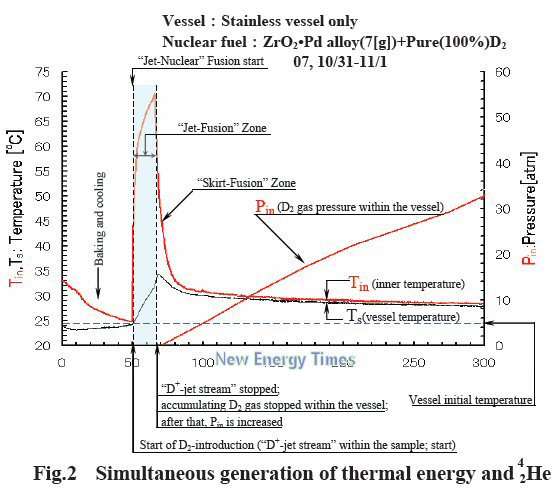
The graph below, Fig. 5B, contains a composite of three experiments. For the moment, we will continue to speak only about the ZrO2Pd alloy + D2 experiment shown above, in Fig. 2. This ZrO2Pd alloy + D2 experiment is highlighted in Fig.5b by the purple area, bounded on top by a red line representing Tin and on the bottom by a black line representing Ts. Arata calls this the "separated state," where Tin is always higher than Ts and they do not join for a long time. According to Arata, this provides additional confirmation that the heating source comes from inside the cell. This graph displays the time period, beginning where Fig. 2 leaves off, at 300, and going to 3,000 minutes.
Another key point is the sustained heating effect, about 2 degrees C above room temperature. Furthermore, the delta T (Tin - Ts) shows sustained heating from within the cell, about 0.5 C higher than the temperature of the thermal isolation chamber. Arata confirmed in an e-mail that the heating effect seen at 3,000 minutes continues in a similar manner for "several hundred hours."
Because there was no input power and because a 2-degree difference from room temperature can be measured confidently with standard laboratory equipment, the signal-to-noise ratio can be considered high and the claimed results rigorous.
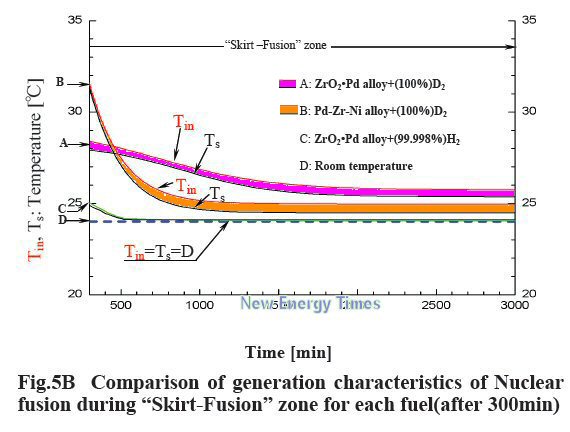
Now let's look at a different experimental run. Fig.3 below displays a Pd-Zr-Ni alloy + D2 experiment. This sample shows the same general characteristics as the previous sample (temperature ascent, descent, pressure ascent). However, the effects of this experiment are less pronounced than the ZrO2Pd alloy + D2 experiment. As shown in Fig. 5b above, indicated with the orange highlight, the Pd-Zr-Ni alloy + D2 experiment sustains a 1-degree C heating effect above room temperature, rather than a 2-degree rise above room temperature. This experiment, like the other, shows a 0.5 C delta T.
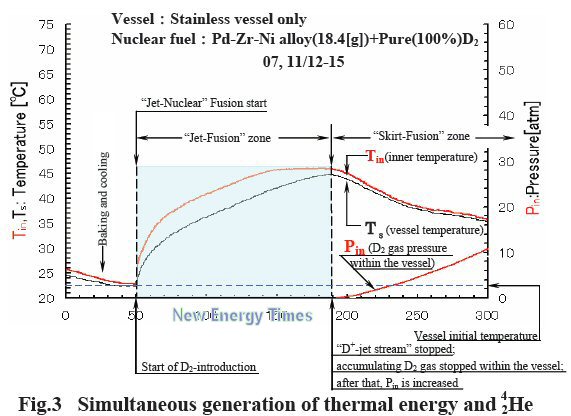
In Fig. 4, the researchers used the ZrO2Pd alloy, but instead of D2, they used H2. The heating effect runs from T=50 to T=500, as seen by viewing both Fig. 4 and Fig. 5b. No delta T is seen with ZrO2Pd + H2 from T=500 to T=3,000. No heating is seen beyond 500 minutes.
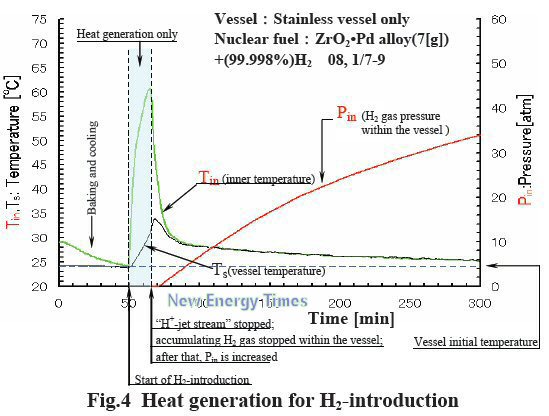
New Energy Times has made a composite of Figs. 2, 3 and 4. Click on the image below for a larger version of this composite.

Arata has made a composite of the "Skirt-Fusion Zone" from each of these experiments. At 300 minutes, the deuterium experiments are 4 degrees and 7 degrees higher than room temperature, and the hydrogen experiment is 1 degree higher than room temperature. He has adjusted the time scale to begin with the onset of the "Skirt-Fusion Zone."
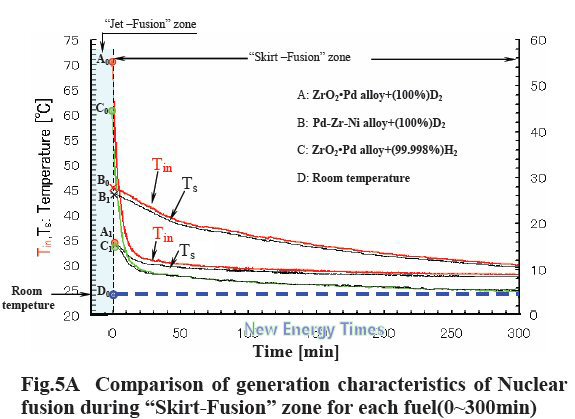
Seeing the beginning of the "Skirt-Fusion Zone" in its run out to 3,000 minutes requires shifting the scales of the x and y axes. New Energy Times has made a composite. Click on the image below for a larger version of this composite.
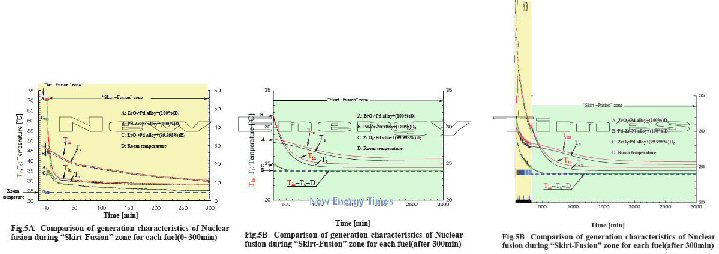
Arata searched for helium-4 both in the headspace (within gas) and the nanopowder sample (within sample) inside the cell (vessel). Questions about "background" helium-4 are irrelevant, according to Arata.
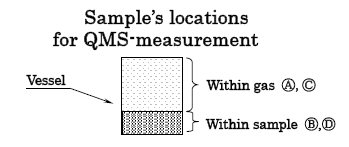
"In my experiments," Arata wrote, "the vessel with sample is baked and vacuumed. After that, 100 percent pure D2 gas is injected into the vessel. There is no 4He in the injected gas. If not, there would be no point to perform these experiments."
Takahashi provided additional information.
"Arata used a Pd tube regulating D2 gas flow from the 100 atm D2 source to remove any He-4 in the source D2 gas and to control the flow rate," Takahashi wrote. "They believed there remained 'no' He-4 in the D2 flow after filtering through the Pd tube which was set before the cell inlet. For the blank run with H2 gas, no He-4 particles were detected."
Arata confirmed Takahashi's statement and said that, for the blank runs, D2 with no sample, and H2 with sample, no 4He was found.
New Energy Times asked Arata whether he was able to detect the 4He concurrent with the heat generation.
"No," Arata wrote. "Due to the nature of the quadrupole mass spectrometers, it is impossible to detect the 4He evolution in the experiment concurrent with the heat generation. The 4He can only be detected after the finish of experiment."
In the hydrogen experiment, virtually no signal for either helium-4 or deuterium is visible. In the deuterium experiment, a distinct presence of helium-4 is observed with the quadrupole mass spectrometers.

New Energy Times asked Arata questions about the various zones.
In the paper, he writes that, in the D+ Jet stream, 4He and thermal energy are produced. He also writes that, in the H+ Jet-Stream, only chemical reaction heat is produced. To the question "How do you determine which is nuclear reaction heat and which is chemical reaction heat?" Arata replied, "Based on the detected results of 4He, you can see the spectra graphs of 4He and D2 (Fig.7)."
It is not clear from the graphs. However, Arata confirmed that his term "Skirt-Fusion Zone" extends all the way to 3,000 minutes.
We asked Arata to explain in greater detail what he meant about the difference between the nuclear fusion reaction and the chemical friction reaction, as he wrote in the paper. He replied that the energy comes from both the nuclear fusion reaction and the chemical frictional reaction.
In the ZrO2Pd alloy + D2 experiment shown in Fig. 2, the region between T=50 and T=58 is marked "Jet-Fusion Zone." In the ZrO2Pd alloy + H experiment shown in Fig. 4, this same region between T=50 and T=58 is marked "Heat Generation Only." Tin goes up to 71C with the deuterium experiment, and Tin goes up to 61C in the hydrogen experiment. We asked Arata why the same respective zones were labeled differently, and we asked him about the meaning of these two labels.
"In my opinion, the difference of temperature (10 degrees) came from 'Solid Fusion,'" he wrote. “The 4He test results show that there is 4He of ZrO2Pd alloy+D2; comparatively, there is almost no 4He of ZrO2Pd alloy+H2. These results support my opinion."
In the ZrO2Pd alloy + H experiment, shown in Fig. 4 and Fig. 5b, there is no noticeable delta T. Arata states that this indicates no nuclear heat in this experiment. He clarified further.
"The energy of ZrO2Pd alloy + H2 is due to chemical reaction," he wrote, "not nuclear heat. It can be confirmed by the results of the 4He test."
Arata states that no input energy is required for the experiment, aside from the energy required to create the initial vacuum and gas pressure and to bake the powder. He considers all energy released from the experiment "excess."
During his lecture, Arata displayed energy calculations from a ZrO2Pd alloy + D2 experiment performed May 1-8. They are displayed below in the photo taken and annotated by Takahashi:
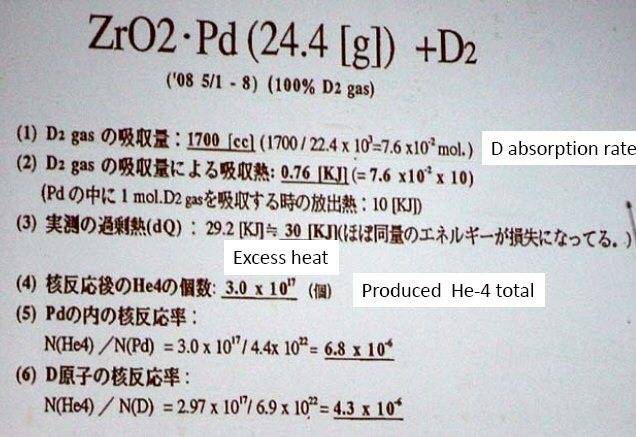
Photo: A. Takahashi
References
- Arata, Yoshiaki, "Research Project of New Energy Generation," J. High Temperature Society, Vol. 34, No.1, Special Report at the end of issue (no pages are given), (Jan 2008)
- Arata, Yoshiaki and Chang, Zhang-Yue, "Establishment of the “Solid Fusion” Reactor," J. High Temperature Society, Vol. 34, No. 2, Special Report at the end of issue (no pages are given), (March 2008)
- Yamaura, Shin-ichi, Sasamori, Ken-ichiro, Kimura, Hisamichi, Inoue, Akihisa, Zhang, Yue Chang and Arata, Yoshiaki, "Hydrogen Absorption of Nanoscale Pd Particles Embedded in ZrO2 Matrix Prepared from Zr–Pd Amorphous Alloys," Journal of Materials Research Society, Vol. 17, No. 6, (June 2002)
__________________________________________________________________________________
11. International News Coverage of Arata-Zhang
Osaka University Demo
| A Chilly Reception for Cold Fusion, The National (United Arab Emirates), June 21, 2008 |
| Cold Fusion Demonstration: An Update, PhysicsWorld.com Blog, June 16, 2008 |
| Kernreaktion im Vortragssaal [Nuclear Reaction in a Lecture Hall], Heise online, May 28, 2008 |
| Cold Fusion Success in Japan Gets Warm Reception in India, India PR Wire, May 27, 2008 |
| Physicist Claims First Real Demonstration of Cold Fusion, Physorg.com, May 27, 2008 |
| Cold-Fusion Demonstration "A Success", PhysicsWorld.com Blog, May 23, 2008 |
| Nikkei Sangyo Shimbun, May 23, 2008, page 10 |
| Demonstration Experiments on Nuclear Fusion in Solids Performed in Osaka Univ.: Metallic Nanoparticles and Deuterium used, and Helium Generation Confirmed, Nikkan Kogyo Shimbun (The Business and Technology Daily News), May 23, 2008 |
Nuclear Energy: Cold Fusion, It Works, Il Sole 24 Ore, May 22, 2008 |
| The Revenge of the Samurai, Il Sole 24 Ore, May 22, 2008 |
Arata-Zhang LENR Demonstration, New Energy Times, May 22, 2008 |
__________________________________________________________________________________
12. Deuterium and Palladium Not Required
By Steven B. Krivit
Interpreting by Renato Mor
[A more technical article, "Piantelli-Focardi Publication and Replication Path," follows this one in this issue of New Energy Times.]
Being first is not always all it's made out to be. Just ask Martin Fleischmann or B. Stanley Pons, who were the first in recent history to publicly announce a claim for achieving a low-energy nuclear (LENR) reaction. Fleischmann left the U.S. shortly after the March 23, 1989, University of Utah press conference and returned to his home in Tisbury, England. According to an author of an early book on the subject, Pons "disappeared, put his house up for sale, disconnected his phone" and left with his family to seek refuge in France.
Or look back earlier in the century to 1926, when two Germans, Fritz Paneth and Kurt Peters, experimenting with hydrogen in palladium, claimed to transform hydrogen into helium "with the aid of particles of metal."
A week after the Paneth and Peters announcement, prominent physicists of the day attacked. Soon after, Paneth and Peters retracted their claim, stating that their observations had been the result of experimental error and contamination from the atmosphere.
Much credit goes to Fleischmann and Pons, who, unlike Paneth and Peters, stuck to their guns and did not succumb to the pressure of their scientific peers and recant. Much appreciation is due Fleischmann and Pons for awakening the scientific world to the anomalies of hydrogen.
Throughout most of the 19-year history of the cold fusion controversy, most researchers in the condensed matter nuclear science (CMNS) field held the opinion that LENR reactions required palladium, an expensive precious metal, and deuterium, a form of hydrogen that exists naturally at a ratio of one deuterium for every 6,000 atoms of normal hydrogen in water. The information contained within this report and other scientific research in the public domain suggests that possible future technological applications of this research will not be bound to the use of palladium, but may instead require the relatively inexpensive metal nickel.
Beautiful Tuscany
Over in Tuscany, Italy, 19 years ago, when something strange occurred in the laboratory of biophysicist Francesco Piantelli, he might not have given it a second thought. But because Fleischmann and Pons had made their excess heat claim publicly known several months earlier, Piantelli did not dismiss as an artifact what he saw before him.
Piantelli's discovery would lead to perhaps some of the most astounding low-energy nuclear reaction excess heat results in the CMNS field: one cell producing 900 MJ of excess heat for 278 days and another cell producing 600 MJ for 319 days. One of Piantelli et al.'s papers, published in Il Nuovo Cimento, states a conservative power rate of 38.9 +/-1.5 Watt excess heat; by another calculation, the authors state, it could be as high as 68 Watts. Regardless of the discrepancy, which they explain, it is very difficult to dismiss this data on account of poor calorimetry. The also reported nuclear particles and emissions.
His Story
Piantelli's story began when he was using a cryogenic device to perform a biophysics experiment. In contrast to Fleischmann and Pons, who were working with deuterium and palladium in a liquid environment, Piantelli used a biophysics device involving nickel and hydrogen in a gas environment. The device was chilled by liquid helium.
"This is my story. It's an old story," Piantelli, now 74, said. "It all started with these experiments you see in this room."
The lab has benches, a wet lab, a clean room and equipment for performing gas experiments. To one side, posters display his and other researchers' scientific achievements. But he arrived at his energy research as an outsider.
What he is willing to tell about himself is this: He retired from the University of Siena two years ago, after 40 years as a professor there and having worked at Olivetti before that. His scientific background is in applied biological physics, physics, biochemistry and intramolecular organisms. His specific interest has been cancer research, and in fact, he is far more interested in cancer research than energy research. He performs some of his work from his company, Centro IMO (Interactions Molecular Organisms).
He was not initially eager to grant New Energy Times an interview; he agreed only after many requests, and he declined to have his photograph taken.
"It started with this biophysics experiment," Piantelli said. "This machine changes the electromagnetic state on a cellular level. If you put a biological cell in this machine, you can see the effect. It eliminates cell division, cancer, melanoma. I've been working on cancer research for 18 years. We are making devices, based on these experiments, on demand. They are being used now in clinical trials in a local hospital."
|
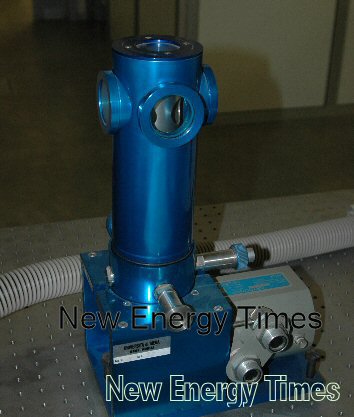
Piantelli's biophysics device
Photo: S.B. Krivit
|
|
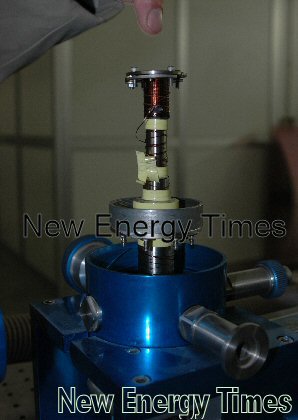
Under the cover of the biophysics device
Photo: S.B. Krivit
|
"During these experiments with a piece of nickel material inside," Piantelli said, "the temperature went up when pressure went down. According to Boyle's law, this should not occur. This is an anomaly. The temperature went up near 160 C, 433 K. It happened on August 16, 1989. I remember the day clearly because it was the same day as the famous horse race here in Siena. The experiment was destroyed because of the extreme temperature."
The graph below shows data from an apparent replication at the University of Pavia that Piantelli said was performed about four years ago. It requires some explanation. Pressure remains constant, he said. Power starts at 44 Watts and is decreased by the experimenter to 40 Watts. During this time, temperature inexplicably goes from 167 C to 200 C.
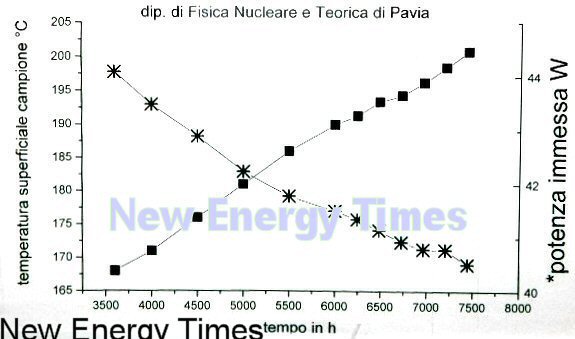
Nickel-Hydrogen gas replication experiment performed at the University of Pavia
The experimental configuration is relatively simple. A small stainless steel cylinder about the size of a beverage can contains a nickel rod 5mm in diameter by 90mm long. Also inside the cylinder is an electrical resistance heater - in concept, much like a coil that is used to heat a cup of coffee or a blanket. Air is pumped out of the cylinder, then hydrogen is gradually introduced. Initially, some of the hydrogen is absorbed, or loaded, into the nickel, and this occurs over the course of several cycles. Once the hydrogen is fully loaded into the nickel, the conditions are created for the as-yet-understood reaction which causes an anomalous heating effect and nuclear signatures.
When his 1989 experiment overheated and was destroyed, Piantelli was irate. He stopped all his research and took time off for a vacation. When he came back, he gave it more thought and restarted one of the experiments.
Over the years, Piantelli, Sergio Focardi (Bologna University), Roberto Habel (Cagliari University and the National Institute of Nuclear Physics-Cagliari) and other colleagues were successful in repeating the experiment several times. One low to moderately independent replication attempt at the University of Pavia initially failed to replicate but succeed several years later, according to documents provided by Piantelli. Another group at Europe's high-energy physics research center successfully reproduced the results but interpreted them negatively. New Energy Times will look more closely at the Pavia and CERN issues in the following article.
Piantelli has been working in his current laboratory for only six months. Before that, he worked in a very small lab on the campus of the University of Siena. His new laboratory in Colle Val d'Elsa, on the outskirts of Siena, was expected to come online by the end of 2004, but it took longer than expected. It was a collaboration between a private company called Lumenergia and Siena University. In the summer of 2007, Lumenergia was bought out by Provita s.r.l.
The future of the Ni-H energy work, Piantelli explained, is all about atomic deposition of elements. To this end, the heart of the new laboratory features a clean room and machine that he calls "Knudsen," which is used to deposit thin films by thermal evaporation and surface preparation.
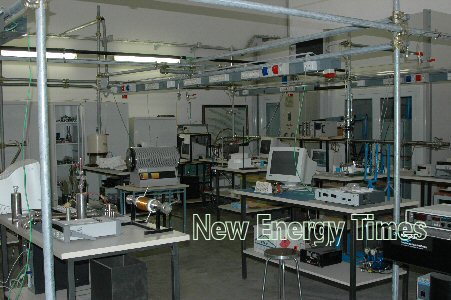
Piantelli's laboratory
Photo: S.B. Krivit
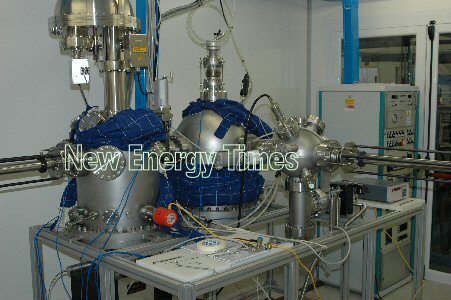
"Knudsen" thin film machine
Photo: S.B. Krivit
"This is the heart of the problem," Piantelli said. "The surface treatment on the nickel rod is the secret; it's fundamental."
Actually, there are more secrets, he said. He didn't mind photographs being taken of anything in the lab. However, he said the real secrets are in his head - that is, the process of the surface preparation and what he's learned of this art in the last 19 years. Piantelli's secretiveness is no different than that of any of the other new energy researchers whom New Energy Times has met. Nobody who seems to have anything significant seems eager to be a saint and give it away.
Piantelli said that he now has the ability to look at the samples before the experiments begin and predict whether the material will work. He said that a special annealing furnace that the Piantelli-Focardi group now has is an essential part of the materials preparation process.
Getting back to the science: Surface effects appear to be a continuing strong trend among LENR researchers as a pivotal aspect of the work. But not too many researchers work with hydrogen and nickel; usually, it is deuterium and palladium. Why nickel? According to Piantelli, it has something to do with the electronic structure. He said it's different for nickel. Palladium works, but it's not as good.
The incentive to be able to release energy from normal hydrogen rather than deuterium, and nickel rather than palladium needs little explanation.
|
Piantelli has some very interesting things to say about deuterium. New Energy Times asked him whether he had ever tried using deuterium instead of normal hydrogen. Yes, he said, but if you put the deuterium inside a hydrogen-based experiment, it stops the reaction instantly. Piantelli said that, if he uses just normal hydrogen with very high purity, which may have a trace amount of deuterium, it works fine. But if he injects even just 2 percent or 3 percent of deuterium with respect to the hydrogen, it stops the experiment, kills it. Whether Piantelli had ever tried pure deuterium, rather than pure hydrogen, was not clear.
This is the strangest information; researchers who are accustomed to working in the deuterium/palladium system say almost the same thing - but the opposite: If you allow any normal hydrogen into the system, you will never get excess heat. It's quite a paradox. For years, the deuterium/palladium researchers have said that the proof that normal hydrogen can't make excess heat is that, time after time, normal hydrogen poisons the excess heat effect in deuterium-based systems. Even the emotive language in their descriptions—"poisons," "kills"—has a similar ring.
So what to make of this? Is it possible that hydrogen works only in a hydrogen system and deuterium only in a deuterium system? What if an inherent characteristic of their respective properties makes each one incompatible with the other? Perhaps there is some kind of frequency cancellation.
Piantelli also explained why he likes to work with hydrogen gas rather than hydrogen in H2O. In electrolysis, he said, your working regime can get up to only 100C. After that, of course, the experiment boils away. With gas, you can work in a much higher regime. He prefers 400C to 450C.
Piantelli has an exciting story to tell of another experiment that, for few hours, was out of control. It was sometime around September 1993, before Piantelli-Focardi group's first published paper on the subject. Around 7 in the evening, he looked at the monitor for the experiment. Something didn't look right. The temperature was increasing rapidly. He wasn't sure what to do. Should he kill the experiment, and if so, how would he stop it?
A rapidly increasing temperature in an enclosed steel container could be a big, big problem. He was afraid. He wondered whether he should leave the building. Instead he called Focardi in Milano—at 2 in the morning—and asked, "What should I do?" This was before Piantelli knew about the poisoning effect of deuterium. But Focardi came up with a workable idea: introduce nitrogen. And it worked. It stopped the uncontrolled temperature rise and killed the experiment.
Piantelli didn't know how hot the experiment had gotten before he killed it because the monitor eventually blacked out. However, the metal thermocouples inside the cell melted. This told him that the temperature exceeded 1450 C. Understandably, he was angry because these experiments take a long time to run and he had to abandon it prematurely.
"It's not good when they run too hot," Piantelli said. "400C is a much better range."
Another interesting part of the Piantelli-Focardi group's experiment, Piantelli explained, was the use of a cloud chamber to detect and observe charged particles. He said he and his colleagues detected alphas and protons from the nickel rod after the experiment was over. He estimated that the rod was kicking out 35-40 emissions per minute even two months after the experiment. The Piantelli-Focardi group could see it with their own eyes. He said he also exposed it to CR-39 and had made some photos from the cloud chamber. He hopes next time to record the cloud tracks with a video camera.
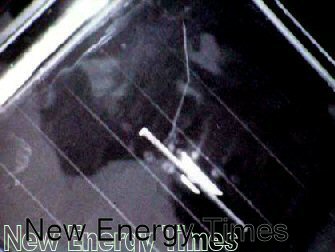
Charged particle track, emitted from nickel rod after Ni-H experiment [1]
|
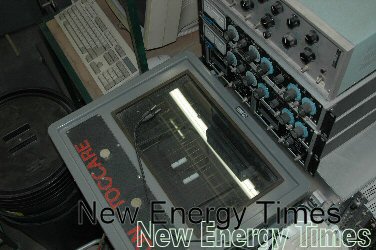
Cloud chamber box
Photo: S.B. Krivit
|
In Memory of Mallove and Huizenga
Piantelli hopes to have his next set of results within a few months. He said he once made a promise to Gene Mallove, at the time editor and publisher of Infinite Energy, to make a successful demonstration experiment. He said he intends to fulfill this promise in Gene's memory and, he says with a grin, for the benefit of John Huizenga, famous for his efforts with the U.S. Department of Energy to impede "cold fusion" research.
Piantelli also has his own theory, and although this writer was not able to follow what Piantelli was saying, aside from a few recognizable words—Edward Teller, 1938 and electroweak—it is obvious from watching him speak that the theoretical challenge and its potential glory stimulate his mind far more than the experimental work.
However, the most important work, he said, is not energy research but health. If Piantelli's interest over the years in the pursuit of clean energy has lapsed, it is only because his heart calls him to a higher purpose: healing the sick.
In a small room in a local hospital, Piantelli stops in to visit and see how things are going. Five people are sitting in tall chairs. Anchored behind each chair, a large, flat, doughnut-shaped ring seems to float in front of each person's chest - a device based on Piantelli's research. For a rough analogy, picture the protective bars on some roller-coaster rides. The bars swing down from the top, over the rider's shoulders and keep the torso in place.
Piantelli said that, if people start using these machines in the early stages of cancer, the machines produce a good remission rate, and they reduce the need for pharmaceutical solutions. Sadly, and perhaps as expected, he said, the pharmaceutical companies have been averse to his research. He said the machines are not able to cure patients in the later stages of cancer, but they are able to reduce or eliminate much of the pain and suffering for the patients' final days.
References
- Campari, E., Focardi, S., Gabbani, V., Montalbano, V., Piantelli, F., Veronesi, S., "Overview of H-Ni Systems: Old Experiments and New Setup," 5th Asti Workshop on Anomalies in Hydrogen- / Deuterium-Loaded Metals, Asti, Italy, (2004)
__________________________________________________________________________________
13. Piantelli-Focardi Publication and Replication Path
By Steven B. Krivit
[This is a follow-up article to "Deuterium and Palladium Not Required," based on the work of Francesco Piantelli, Sergio Focardi and colleagues, published in this issue of New Energy Times.]
After Francesco Piantelli discovered excess heat in a nickel-hydrogen system on Aug. 16, 1989, and after his rage about his destroyed experiment subsided, he regrouped and gave it another try.
In February 1990, he saw the heating anomaly for the second time. But this time, he controlled the input power carefully and avoided getting into the higher temperature realm that would compromise the integrity of the cell. After a few cycles of loading the hydrogen gas into the cell containing the nickel sample, he decreased the power, and he saw the temperature rise. The pressure stayed constant. This confirmed to him that he was onto something real, anomalous and, more important, significant.
As we wrote in the previous article, throughout most of the 19-year history of the cold fusion controversy, most researchers in the condensed matter nuclear science (CMNS) field held the opinion that LENR reactions required palladium, an expensive precious metal, and deuterium, a form of hydrogen that exists naturally at a ratio of one deuterium for every 6,000 atoms of normal hydrogen in water. The information contained within this report and other scientific research in the public domain suggests that possible future technological applications of this research will not be bound to the use of palladium, but may instead require the relatively inexpensive metal nickel.
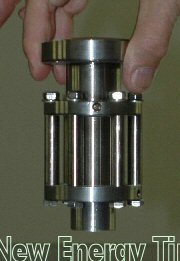
1992 Piantelli-Focardi Ni-H Cell
Photo: S.B. Krivit
|
|
The Piantelli-Focardi group wrote an outstanding chronology of the history of the related experiments on Page 2 of "Overview of H-Ni Systems: Old Experiments and New Setup."[19]
However, the researchers’ seminal paper is "Anomalous Heat Production in Ni-H Systems,"[3] published in the Italian Physics Society's Il Nuovo Cimento in 1994. They reported an experiment performed at the University of Siena beginning in October 1993 that produced "50 Watts of anomalous heat production in a hydrogen-loaded nickel rod" with a "mean power imbalance of 44 Watts for a period of 24 days, corresponding to 90 MJ."
Dieter Britz, a longtime independent observer of LENR research, summarized the paper: "A Ni rod, 5 mm diameter and 90 mm long, was placed in a cylindrical chamber, surrounded by a Pt heater coil. The chamber could be evacuated or filled with gas (H2 or D2) at various pressures. The system was checked by replacing the Ni rod with a stainless steel one, and its temperature was noted as a function of heater power applied and gas pressure. With the Ni rod, the best temperature for H2 absorption was found to be 173C. Some Ni rods showed the expected temperature as a function of heater power in a H2 atmosphere, and others had elevated temperatures, showing that there was excess heat, on the order of 20-50 Watts, with heater power at 40-120 Watts."
|
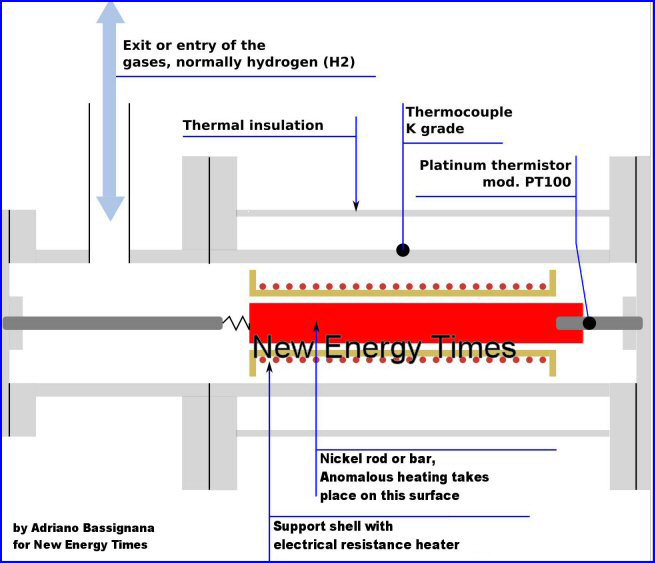
Conceptual diagram of Piantelli-Focardi-type Ni-H Cell

Engineering drawing of Piantelli-Focardi-type Ni-H Cell (Click for larger image)
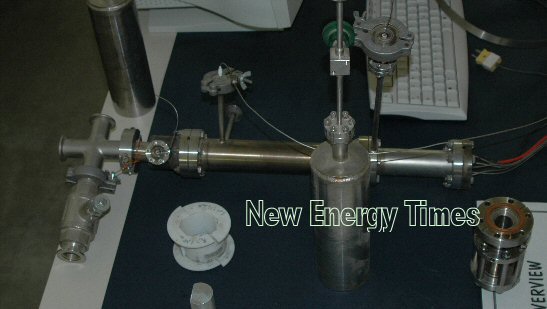
1992 Piantelli-Focardi Ni-H Cell (It's the long horizontal object lying on table)
Photo: S.B. Krivit
In the authors' own words, "the gas absorption was accompanied by a strong rise of the rod temperature standing high for such a long time [so as] to render the heat production involved incompatible with any classical theory."
The authors also reported that they attempted but failed to detect neutrons and gamma rays above background during the process. This paper cites only one reference: the preliminary note [1] of Martin Fleischmann, B. Stanley Pons and Marvin Hawkins.
After the Piantelli-Focardi researchers’ paper published, they held a press conference which was covered by Foresta Martin Franco of Corriere Della Sera in Milano, Italy.[4] The news report, and the press conference, convened by local politician Luigi Berlinguer, occurred on Feb. 19, 1994.
"The research," the paper quoted Berlinguer as saying, "even though underfunded, can produce great results." ("La ricerca, anche se sostenuta da mezzi poveri, può produrre grandi risultati.")
Failure to Replicate at CERN
The next publishing milestone is the report of the attempt by researchers at CERN, the European center for high energy physics research, to replicate the Piantelli-Focardi group’s work. The CERN group's report published in December 1996 in Il Nuovo Cimento [9]. It is a peculiar report.
The authors state, "We have found the [Piantelli-Focardi group’s] results to be consistent with our observations; namely we measured higher temperatures for the same input power when hydrogen is absorbed during a heating cycle. Nevertheless this temperature rise does not appear to correspond to an increase in heat production. We have added a temperature sensor to the container of the experiment.
“The temperature of the container follows the same temperature with input power curve irrespective of whether there is an anomalous absorption of hydrogen or not; therefore we have no evidence that this temperature increase corresponds to another source of heat. In conclusion, we have observed all the effects discovered by Focardi et al., but our results imply that there is no production of power associated with the absorption of hydrogen by nickel."
It is most peculiar. They see heat, as did the Piantelli-Focardi group, but their interpretation is that it is not anomalous.
Another interesting thing about the CERN paper is that, despite the fact that the Piantelli-Focardi researchers make no claim for fusion in their paper, aside from the journal's classification of the paper, the CERN authors critique this nonexistent claim - in other words, introducing a "straw man" argument. The only related statement the Piantelli-Focardi group makes is that "work is now in progress to verify as a possible candidate for the heat generation the reaction (p, D), where D is that naturally contained in hydrogen." No mention of fusion, no mention of any reaction chain.
However, the CERN authors lead off their article making a theoretical argument against the Piantelli-Focardi group’s paper, implying that the Piantelli-Focardi group is making a claim of fusion. The CERN group introduce the reaction pD > 3H3 + gamma and present the improbabilities of such as a critique to the Piantelli-Focardi group. The Piantelli-Focardi researchers also say nothing in their paper about helium, and what they say about gamma is that they failed to detect any above background.
The CERN group concludes its first section discouragingly: "Thus, the reaction pD appears to be an unlikely candidate."
The CERN paper's opening argument was disingenuous for the reason described above, as well as because the authors’ attempt to use known theory to discredit the Piantelli-Focardi group’s empirical work was unscientific.
The CERN authors admit that they lack information from the Piantelli-Focardi group’s paper. Perhaps these were essential details responsible for the failure to replicate.
They state that the Piantelli-Focardi researchers "do not specify exactly what they consider a loading cycle" – that is, CERN states, "On some occasions we observed absorption of hydrogen: The gas pressure started to decrease while the temperature of both the coil and the rod increased."
Piantelli understands this process of loading clearly. He said, at least in the years following, that the process of loading the hydrogen properly into the nickel to attain a steady pressure is a prerequisite to seeing anomalous heat.
Later in the CERN authors’ paper, they state, "We found that this phenomenon of absorption of hydrogen was not reproducible."
This is important. Without the proper hydrogen absorption into the nickel, excess heat almost certainly will not occur. This is exactly what Michael McKubre, director of energy research at SRI International, has said for many years about the D/Pd system: If you do not achieve the minimum loading threshold, you almost never see excess heat. But the language in the CERN statement has a political edge: The statement does not say the phenomenon was irreproducible in the group’s work; it says that the phenomenon was irreproducible, period.
Finally, the CERN authors write that they tried a 50/50 mix of hydrogen and deuterium and that, as well, failed to produce the claimed result. As Piantelli explains in "Deuterium and Palladium Not Required," he now knows very well that the introduction of deuterium will kill any chances of a positive result.
This work, although it entails a significant effort, does not represent an effective critique of the Piantelli-Focardi group's work, though it does provide useful information about an experiment that fails to replicate that work.
Piantelli-Focardi Group Responds to CERN
In November 1998, the Piantelli-Focardi group published "Large Excess Heat Production in Ni-H Systems,"[14] again in Il Nuovo Cimento. The paper directly responds to the most significant criticism of the 1996 CERN paper.
In the Piantelli-Focardi authors’ introduction to their new paper, they state that they modified the cell they reported in 1994 [3] with "an improvement which allows the measurement and the monitoring of the external surface temperature."
"With this new set-up," the Piantelli-Focardi group writes, "the external temperature increase, together with the internal one, have been utilized to characterize the excited state of the Ni sample. The existence of an exothermic effect, whose heat yield is well above that of any known chemical reaction, has been unambiguously confirmed by evaluating the thermal flux coming from the cells."
The paper clarifies the term "excited state" as the phase in which the experiment was producing anomalous heat.
Britz wrote the follow summary of the 1998 Piantelli-Focardi group’s paper: "In addition to a cell used by this team earlier, consisting of a tubular vacuum chamber with a heating mantle around a Ni rod and a single temperature probe on the outside and the inside of the mantle, a new cell has now been designed with multiple probes.
“Hydrogen gas was admitted to the chambers, which were heated, and temperatures measured. Transient lowering of the input power produced, upon restoring the power, temperatures higher than before the transients. This showed the presence of nuclear phenomena, and calibrations performed calculated roughly 20 Watts of excess power generated by the hydrided Ni rods. The effect, once started, lasted for 278 days, the duration of the experiment."
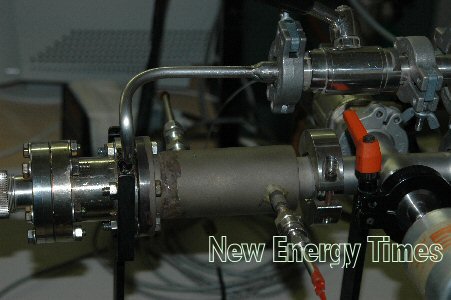
2007 Piantelli-Focardi Ni-H Cell
Photo: S.B. Krivit
In their 1994 paper, the Piantelli-Focardi researchers report that they saw no neutrons or gamma rays, though they later reported morphological changes in the nickel rods.[20] In the introduction of their 1998 paper, they report "very clear evidence of neutrons and gamma rays," though these had been reported several years earlier, in 1995 [7], 1996 [8] and 1997 [13] in conference proceedings.
The next major paper from the Piantelli-Focardi researchers was published in September 1999 [16], again in Il Nuovo Cimento. One of their colleagues, Adriano Battaglia, had died, and they dedicated the paper to his memory.
"In this paper," the authors write, "evidence is reported for neutron emission during energy production in Ni-H systems at about 700 Kelvin. Neutrons were detected directly by 3He counters and indirectly by gold activation."
The paper goes into great detail about the arrangement and preparation of the three separate, independently powered neutron detectors and their careful efforts to isolate background cosmic-ray emissions. They report a temporal correlation of the neutron measurements along with the excess heat measurements.
"Two methods were used for neutron detection: direct counting by means of neutron detectors," the authors write, "and counting of gamma rays emitted by neutron activated gold."
The authors report a brief period of significant neutron activity above background that occurred during a heat excursion so strong that they had to drop the input power to the system several times in order to keep the system stable.
|
"Several input power reductions were needed to keep the
working point temperature
as constant as possible." |
"Such large deviations from the mean value," the authors write, "occurred during a brief period for which the power emitted from the cell 'A' had a spontaneous increase (on the order of 10 Watts), and several input power reductions were needed to keep the working point temperature as constant as possible."
The authors explained the logic behind their secondary neutron detection approach.
"A few elements," the authors write, "as is well-known, have a high thermal cross-section for neutron capture. Among these, gold also has the characteristic of having some resonance peaks at energies higher than the thermal one. 197Au transmutes into 198Au by the reaction 197Au(n, gamma) 198Au. The latter decays with a 2.7-day half-life according to the process

in the 198Hg (411.8) level with a 99 percent branching ratio. The 198Hg decays to the ground state by emission of a 411.8 keV gamma-ray."
The evidence for their hoped-for gamma ray peak is shown below.
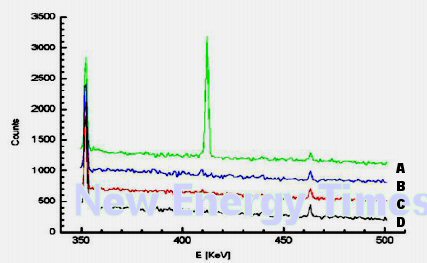
"Gamma-ray spectra in the 350-500 keV region obtained with a germanium detector for: (a) gold sheet after the activation for 12 days on cell A; (b) gold sheet after the same exposition time to cosmic rays 10 m away from the cell; (c) gold sheet before the activation on the cell; (d) laboratory background." [16, 19]
The paper reports a few other inexplicable anomalies and concludes that the data fall outside of current knowledge of nuclear physics.
University of Pavia: Failure to Replicate or Positive Confirmation?
One inexplicable part of the Piantelli-Focardi group’s history is the statement made by Adalberto Piazzoli of the physics department at the University of Pavia. Piazzoli also is vice president of CICAP (Italian Committee for the Control of the Affirmations on the Paranormale). He refers to an alleged failed replication attempt by one of his students, for whom he was an advisor.
"Unfortunately, we have not been able to reproduce some of the results of the cited colleagues," Piazzoli writes, "but we know that, in the study of unknown phenomena, even though existing, the confirmations and refutation do not have the same verification value. Our esteem for our colleagues of Florence and Siena remains naturally unchanged."
Piazzoli's comments appear in the March/April 2008 issue of Scienza & Paranormale and there are two discrepancies. This first is in his language, which translates to "refutation." He writes that confirmations and refutations do not have the same verification value.
Yes, there is some truth to this, but he seems to have used the wrong term. The term should be "failure to replicate," not refutation.
The second anomaly is the display in Piantellil’s laboratory of the poster and data which discuss a nickel-hydrogen gas replication experiment performed at the University of Pavia. One of the graphs representing this data is in the "Deuterium and Palladium Not Required" article.
[Note added on May 18, 2013: New Energy Times has been unable to find a full source reference for the Luigi Nosenzo (University of Pavia) and Luigi Cattaneo of Consiglio Nazionale Ricerche (National Research Council.) research done at Pavia. The fact that Piazzoli is the vice president of the Italian skeptics society suggests that he may have a conflict of interest and may not necessarily, or accurately, represent the views and findings of the original researchers. New Energy Times does not have information that, beyond a thesis advisor, Piazzoli was part of any Pavia reseach team that did this work.]
Other Evidence
As mentioned earlier, the paper "Overview of H-Ni Systems: Old Experiments and New Setup" is an excellent source of information and perhaps an ideal starting point to learn more about this group's work. The paper also estimates the neutron flux, noted above, at a rate of 6,000 neutrons per second and shows the expected Compton peak. The Compton peak is famous among "cold fusion" skeptics for its absence from gamma-ray data in the March 1989 Fleischmann-Pons paper submitted to but rejected by Nature.
The Piantelli-Focardi group's paper "Surface Analysis of Hydrogen Loaded Nickel Alloys" [20] reports SEM analysis which provides evidence for low-energy nuclear transmutation, and the group’s paper "Evidence of Electromagnetic Radiation from Ni-H Systems" [21] presents evidence for photon emission. Many other Piantelli-Focardi group papers from conference proceedings are available; some of them are listed in the reference section.[10, 12, 17,18] Piantelli also provided New Energy Times with an set of miscellaneous graphs and images. They are available here.
An interesting point in the related work is the common absence of excess heat when tritium is detected. [2,5,6,11] This same relationship with the D/Pd systems has been observed and reported by several researchers, specifically by McKubre in several conferences last year. It also will be published in a report from his group in the forthcoming American Chemical Society book "Low-Energy Nuclear Reactions Sourcebook," edited by Jan Marwan and Steven B. Krivit. [22]
A related paper by Giuliano Mengoli et al., "Anomalous Heat Effects Correlated With Electrochemical Hydriding of Nickel," was published in Il Nuovo Cimento in March 1998.[15]
Britz wrote the following comments to summarize the paper: "This is a confirmation of [LENR] in the Ni/light water system, but the Mills theory is rejected (a good brief history is provided). The authors note that this system shows better reproducibility than Fleischmann-Pons-type heavy water systems, but the Mills' theory is refuted by experiments of Piantelli. …
“Both isothermal and non-isothermal calorimetry was used, at three working bath temperatures: 50C, 80C and 99C. Significant (up to 20-30 sigma) excess heat was found, increasing with temperature; but no blank controls were possible. Some (a few) runs failed, producing no excess heat in these; the cathodes were preoxidised, or organic impurities had been in these cells. Thus, surface treatment is important. There was a marked aftereffect - that is, excess heat after current cut-off."
Mengoli et al. wrote, "We believe that the findings of both Mills and Piantelli have a common origin: In other words, the thermal effects observed in either electrolytic or dry environments start from the same physical-chemical state of the system. Although this is far from being an explanation of the phenomenon, elucidation of the physical-chemical conditions suitable for its induction is the first step in understanding it."
References
- Fleischmann, M., et al., "Electrochemically Induced Nuclear Fusion of Deuterium," Journal of Electroanalytical Chemistry, Vol. 261, Issue 2, Part 1, p. 301-308 (April 10, 1989) and errata in Vol. 263, p. 187-188, (1989)
- Srinivasan, M., et al., "Tritium and Excess Heat Generation During Electrolysis of Aqueous Solutions of Alkali Salts With Nickel Cathode," Proceedings of the Third International Conference on Cold Fusion, Nagoya, Japan, Universal Academy Press Inc., Tokyo, Japan, (1992) [Ed: Srinivasan states that he has since withdrawn the excess heat part of the results because he found later that recombination does take place within an open cell, which could account for the excess heat.]
-
Focardi S., Habel R., and Piantelli F., "Anomalous Heat Production in Ni-H Systems," Nuovo Cimento, Vol. 107A, p. 163-167, (1994)
-
Franco, Foresta Martin, "Siena scopre l' energia pulita Fusione fredda all' italiana?," Corriere Della Sera, (Feb. 19, 1994)
-
Notoya, R. et al., "Tritium Generation and Large Excess Heat Evolution by Electrolysis in Light and Heavy Water-Potassium Carbonate Solutions With Nickel Electrodes," Fusion Technology, Vol. 26, p. 179, (Sept. 1994)
-
Sankaranarayanan, T.K., Srinivasan, M., Bajpai, M.B., and Gupta, D.S., "Evidence for Tritium Generation in Self-Heated Nickel Wires Subjected to Hydrogen Gas Absorption/Desorption Cycles," Proceedings of Fifth International Conference on Cold Fusion, Monte-Carlo, Monaco: IMRA Europe, Sophia Antipolis Cedex, France, (1995)
-
Focardi S., Gabbani V., Habel R., Montalbano V., Piantelli F. and Veronesi S., "Status of Cold Fusion in Italy," Siena Workshop, Siena, 24-25 (March 1995)
-
Focardi S., Gabbani V., Habel R., Montalbano V., Piantelli F. and Veronesi S., [paper name missing], Atti Accad. Fisiocritici, Serie XV, Tomo XV p.109-115, (1996)
- Focardi, S. Gabbani, V, Montalbano, V., Piantelli, F., Veronesi, S. "Evidence for Nuclear Reactions in Ni-H Systems I: Heat Excess Measurements," (no publication details known.)
- Cerron-Zeballos, E., Crotty, I., Hatzifotiadou, D., Lamas Valverde, J., Williams, M.C.S., and Zibichi, A., "Investigation of Anomalous Heat Production in Ni-H Systems," Nuovo Cimento, Vol. 109A, p. 1645-1654, (1996)
- Focardi S., Gabbani, V., Montalbano, V., Piantelli, F., and Veronesi, S., "Analisi Superficiale Con Mocrosonda X Delle Barrette Metalliche Utilizzate Per La Produzione Anomala Di Energia Negli Esperimenti Di Siena, Atti Acc. Fisiocritici Siena, Serie 15, Tomo 15, p. 109-115, (1996)
- Sankaranarayanan, T.K., Srinivasan, M., Bajpai, M.B., and Gupta, D.S., "Investigation of Low-level Tritium Generation in Ni-H2O Electrolytic Cells," Fusion Technology, Vol. 30, p. 349, (1996)
- Focardi, S., Gabbani, V., Montalbano, V., Piantelli, F. and Veronesi, S., "On the Ni-H System," Asti Workshop in Hydrogen- /Deuterium-Loaded Metals, (27-30 November 1997)
- Focardi S., Gabbani V., Habel R., Montalbano V., Piantelli F. and Veronesi S., [paper name missing], Asti Workshop on Anomalies in Hydrogen/DeuteriumLoaded Metals, Asti, (27-30 November 1997)
- Focardi, S., Gabbani, V., Montalbano, V., Piantelli, F. and Veronesi, S., "Large Excess Heat Production in Ni-H Systems," Nuovo Cimento, Vol. 111A, p. 1233-1242, (1998)
- Mengoli, G., Bernardini, M., Manducchi, C., and Zannoni, G., "Anomalous Heat Effects Correlated With Electrochemical Hydriding of Nickel," Il Nuovo Cimento, Vol. 20 D, p. 331-352, (1998)
- Battaglia, A., Daddi, L., Focardi, S., Gabbani, V., Montalbano, V., Piantelli, F., Sona, P.G., and nesi, S., "Neutron Emission in Ni-H Systems," Nuovo Cimento, Vol. 112 A p. 921-931, (Sept. 1999)
- Campari, E. G., Focardi, S., Gabbani, V., Montalbano, V., Piantelli, F., Porcu, E., Tosti E. and Veronesi, S., "Ni-H Systems," Proceedings of the 8th Conference on Cold Fusion, p. 69-74, (2000)
- Focardi, S. and Piantelli, F., "Produzione Di Energia E Reazioni Nucleari In Sistemi Ni-H A 400 C," XIX Congresso Nazionale UIT, 2004 (PPT)
- Campari, E., Focardi, S., Gabbani, V., Montalbano, V., Piantelli, F., and Veronesi, S., "Overview of H-Ni Systems: Old Experiments and New Setup," 5th Asti Workshop on Anomalies in Hydrogen- / Deuterium-Loaded Metals, Asti, Italy, (2004)
- Campari, E.G., Focardi, S., Gabbani, V., Montalbano, V., Piantelli, F., and Veronesi, F., "Surface Analysis of Hydrogen-Loaded Nickel Alloys," Proceedings of the Eleventh International Conference on Condensed Matter Nuclear Science, Marseille, France, (2004)
- Focardi, S., Gabbani, V., Montalbano, V., Piantelli, F. and Veronesi, S., Focardi, S., et al. "Evidence of Electromagnetic Radiation From Ni-H Systems," Proceedings of the Eleventh International Conference on Condensed Matter Nuclear Science, Marseille, France, (2004)
- Marwan, Jan and Krivit, Steven B. eds., "American Chemical Society Symposium Series: Low-Energy Nuclear Reactions Sourcebook," Oxford University Press, ISBN 978-0-8412-6966-8, (Fall 2008)
__________________________________________________________________________________
14. BlackLight Power—Yesterday and Today
By Jones Beene
Introducing Randell Mills
Few people in energy science are more controversial than Dr. Randell Mills. He is a “renaissance man” and hero inventor to his supporters but regarded with vocal skepticism by most of mainstream physics. Regardless, some of his critics concede that he has an astounding intellect and level of accomplishment in both medicine and physics.
Mills' company, BlackLight Power Inc., attracted a fair amount of publicity on May 28 for its bold claim that "the company has successfully developed a prototype power system generating 50,000 watts of thermal power on demand." This claim appears questionable considering that the best that Mills has presented to the public thus far is 41 Watts from an experiment performed 15 years ago at another company, Thermacore.
Mills' accomplishments have brought an almost cultish following, as evidenced by passionate defenders of Mills in numerous Internet forums. Unlike many inventors, he has backed his laboratory work with a complex and evolving theory-of-everything. His theoretical work, "The Grand Unified Theory of Classical Quantum Mechanics," is a massive self-published tome, described by Mills as involving classical quantum mechanics.
On many occasions, Mills has improved the theory based on the objections of others or comments from the online discussion groups, but he has often done so without attribution, which has not endeared him to critics. An in-depth critique of Mills' work by a noted skeptic, Dr. Peter Zimmerman (emeritus professor of science at King's College London ) is available online.
Introducing BlackLight Power
BlackLight Power, located in Cranbury, N.J., is the successor to Mills' first company, HydroCatalysis Power Corp. of Lancaster, Pa. The name change reflects the importance of ultraviolet photon emission (commonly called “blacklight”). The new corporate name also gives the appearance of distancing the company from its origin in water-based electrolysis and the "cold fusion" controversy and from a collaboration with a company called Thermacore. One patent that resulted from that collaboration is not part of the intellectual property of BlackLight (USPTO # 5,273,635).[1]
BLP is privately financed but with significant investment from public corporations. More than $50 million has been raised, and some reports double that figure. Most details of financing and research are closely guarded company secrets.
In the early 1990s, Mills jointly discovered with Thermacore Inc. convincing evidence of excess heat being generated from light water electrolysis. Excess heat means more heat coming from an experiment than can be accounted for by explanations involving prosaic physical processes.
In a contract report performed for the U.S. Air Force Wright Laboratory in 1993, Thermacore makes a case for excess heat. The report states that Lehigh University professor A. Miller "found the hydrino molecule absorbed on the surface of nickel cathodes used in electrolysis of K2CO3." The hydrino "molecule" consists of two bound hydrinos with an ionization potential of 54.4 eV, which was verified by electron spectroscopy for chemical analysis.
If correct, this heat anomaly suggests a previously unrecognized source of energy which materializes in the ultraviolet spectrum but which Mills vehemently claims is of non-nuclear origin. The original patent from the early work did not mention the hydrino by name. The technique used potassium as a catalyst and nickel for the electrodes. Thermacore was later bought by Modine Inc. and, in a quirk of history, underwent restructuring and moved on to other things besides alternative energy.
Some observers feel disappointed that, among the most convincing evidence for the BlackLight process, is a 15-year-old quote which comes from outside the company:
|
"Light water electrolytic experiments at Thermacore show positive results. The most outstanding example is a cell producing 41 watts of heat with only 5 watts of electrical input. The cell has operated continuously for over one year.”
|
The extended operation of this cell is notable, but less so than the puzzling decision to abandon a direction of inquiry with so much promise.
Early support for the Mills experiment also came from Vesselin C. Noninsky, an internationally distinguished calorimetrist well-known by LENR researchers for his role in debunking Caltech's debunking of Fleischmann and Pons.
According to Giuliano Mengoli, an Italian LENR researcher, Noninski "was the first to confirm Mills' findings through reliable heat loss differential calorimetry."[2]
Mengoli also wrote that Robert Bush (California Polytechnic Institute, Pomona), Mahadeva Srinivasan (Bhabha Atomic Research Centre), Reiko Notoya (Hokkaido University), Tadayoshi Ohmori (University of Hokkaido) and Michio Enyo (Hakodate National College of Technology) also observed excess heat in similar experiments.
The Hydrino and the BLP Process
Mills describes the so-called “hydrino” as a stable “redundant ground state” of hydrogen in which the electron orbital is decreased in a step-wise progression. The “deuterino” is the corresponding redundant ground state of the heavier isotope, deuterium. The redundancy occurs in multiples of 13.6 eV in Mills' theory, which totally contradicts standard quantum mechanics. The BlackLight experimental work appears solid to many experimenters and investors but is not without its own controversy: Critics allege a lack of “truly independent” replication.
For example, some aspects of the Mills claims have been replicated and published by Jonathan Phillips of the University of New Mexico. New Energy Times does not know for certain how much personal assistance Phillips had from BlackLight or whether BlackLight constructed the apparatus for him. New Energy Times does know that Mills’ name is on at least three jointly written papers. Phillips’ name is also listed as one of the inventors on Mills' U.S. patent assigned to BlackLight. And according to the Wall Street Journal, Phillips has received consulting fees from BlackLight.
In Issue # 28 of New Energy Times, Steven B. Krivit has proposed “A Model to Quantify the Independence of Scientific Replication.” It is intended to be a gauge of the reliability of reported data for the wider scientific community. In this context, Mills' claims for independent replication are seldom close to meeting the highest standard, and most are in the moderate range. BlackLight also insists on what has been called an “extreme” nondisclosure agreement and on other secrecy measures which many scientists who otherwise might be interested in independent replication refuse to sign.
Part of this lack of independence and openness may be the result of intellectual property and commercialization concerns, which are more problematic for BlackLight than for LENR. Mills has experienced continuing patent problems, first with the United States Patent and Trademark Office and more recently in the UK. This appears to be the result of an attempt to frame theory (which is not patentable, even if correct) as an all-encompassing blanket to cover many unspecified devices in which hydrogen anomalies are found. If that were allowed, any invention which is ever shown to employ the hydrino (even if the word “hydrino” is never used) would be an infringement.
Initially, in the early 1990s, Mills' experiments were published in the journal Fusion Technology,[3] and there he attempted to explain Fleischmann and Pons' "cold fusion" as a non-nuclear variation of his hydrino process. Mills later stated that "lower-energy atomic hydrogen atoms, hydrinos, each have the same mass and a similar interaction as the neutron."[4]
In contrast, Jean-Pierre Vigier from France and other researchers working with light hydrogen have used the name “hydrex” to describe a “virtual neutron” which appears identical to a deeply shrunken hydrino except for its short lifetime.[5] Mills never publicly retracted his general claims about LENR from that period - the excess heat from deuterium electrolysis is essentially non-nuclear - even after the appearance of helium and transmutation evidence was discovered.
Although previously undetected in solar astronomy, hydrinos are asserted in the CQM theory to form readily in the sun's corona and are detectable in spectral lines which were formerly attributed to other isotopes. Hydrinos are also identified with “dark matter,” which solves a number of longstanding cosmological problems, according to Mills.
Is a “Deuterino” Involved in an Early Stage of LENR?
The possibility that orbital shrinkage of deuterium could somehow involve LENR processes, where the palladium matrix provides the necessary environment, is one theoretical possibility which has tantalized a few researchers in the LENR camp who have kept an open mind on both lines of experiment. The LENR models that claim to account for "cold fusion" through Quantum Mechanical tunneling, if applied without another variable to increase statistical probability (known as “cross section”), have profound weaknesses. The hydrino-related “hydrex” theory is a similar explanation.[6]
A few LENR researchers who have found the current LENR theories largely deficient to explain "cold fusion" have looked to Mills for an alternative way to understanding LENR phenomena. Ironically, Mills has not dismissed specifically the possibility of redundant ground state shrinkage as being a predecessor state to higher-probability tunneling, but neither does he accept the reality of Quantum Mechanics precepts like tunneling per se. Consequently, reconciliation is not possible without substantial modification of the original theory. That stalemate is unlikely to change.
This theoretical “crossover” is a complex topic, especially because, according to some but not all LENR researchers, LENR appears to have at least two distinct, disparate groups of reaction processes: one primarily produces heat and helium-4 and another produces heat and transmutation of heavy elements.
What's New at BLP?
Recently, BlackLight issued a press release about a 50 kilowatt “solid fuel” power module and showed a peer-reviewed journal article demonstrating excess heat from diffuse plasmas of light hydrogen. The anomalous heat results were documented in a fashion that LENR enthusiasts will appreciate: water bath calorimetry.[7]
However, the percentage of excess energy reported is below that of many older cold fusion experiments, even below Mills/Thermacore work going back to the early 1990s. The bulk of the previous published evidence for anomalies from BlackLight involved Balmer line broadening and spectroscopy. The line-broadening evidence recently came under fire from critics and thus may have been one motivation for the new calorimetry publications.[8]
The solid fuel reactor claimed by BlackLight is of an apparent output level which could power an automobile, if it were indeed net electrical energy, which is not clear; consequently, it has created much interest in the science press. Detailed information available to the public is too sparse to evaluate this reactor properly.
Critics were quick to link the modest calorimetry results from the journal articles to the power module, because they all appeared simultaneously on the company Web site. In the worst case, that linkage suggests that the reactor could never be self-powering because the usable energy gain, as evidenced in the calorimetry, is less than 200 percent.[9]
One detail worthy of mention is the level of enthusiasm from a respected expert: Dr. Shelby Brewer, former chief executive officer of Combustion Engineering in the U.S. and a Reagan administration expert on nuclear energy. Brewer is also a board member of BlackLight.
His background with the Swiss energy giant ABB Group (formerly Asea Brown Boveri) is suggestive of the kind of blue-ribbon licensees and partners being sought by BlackLight from the manufacturing sector. The company’s business model includes licensing of the reactor to manufacturers who specialize in energy production, but no manufacturers' names, to New Energy Times' knowledge, have been disclosed publicly.
On two occasions, a similar flurry of announcements and press releases from the company - one regarding energy conversion using a Capstone micro-turbine and the other regarding a “reverse gyrotron” - were followed by new rounds of financing. The gyrotron, in particular, was a direct thermal-to-electric converter (heat into electricity) which received a highly enthusiastic response from the newsgroups that follow this technology. Neither announcement materialized as a commercial product or even as a public demonstration of a working device of any kind.
Evidence of former optimism in providing the long-awaited public demonstration, as quoted from Randell Mills himself, is found in the 1998 Art Rosenblum interview, in which Mills stated, “And the thing is, right now we're working on a 100kW thermal unit up at Thermacore in Lancaster. Once we got that, then you can put that into cars, you can put that into distributor power generation ... in developing countries where they don't have transmission lines that could meet an enormous percentage of the market. … We're probably about six months from having that built.”
A computer software molecular modeling product called “Millsian” is the only commercial product available from the company. However, even the appearance of cash flow and product line – software – is dubious. This product, which is only marginally related to the hydrino, has left Mills’ critics wondering why Mills, who claims to have such a potentially transformative technology, would allow himself to be distracted by anything else.
How Might the BLP Process Be Related to LENR?
Reports involving nuclear transmutation and excess heat from (light) hydrogen have long been published from researchers who are more closely identified with LENR, going back to the early 1990s; and this is possibly relevant to a broader theoretical context. Miley, G.H. and P. Shrestha, “Overview of Light-Water Hydrogen-Based Low Energy Nuclear Reactions. in The 12th International Conference on Condensed Matter Nuclear Science” (2005) Yokohama, Japan.]
These experiments, which are suggestive of a cross connection, include the SPAWAR measurements of energetic particles detected by CR-39 detectors.
Edmund Storms, formerly with Los Alamos National Laboratory and now working with Brian Scanlan of KivaLabs of Greenwich, CT, is one of the few LENR researchers who has published the suggestion that the hydrino is involved in LENR. (See his book: The Science of Low Energy Nuclear Reaction: A Comprehensive Compilation of Evidence and Explanations.)
Mills and BlackLight have tried over the years to avoid association with the broader field of LENR. This may be understandable in an historical context because of the prior stigma of "cold fusion," but it is difficult to justify logically with the information that is available in 2008.
No Definitive Answer
This new material from BlackLight adds little more than an increased level of hope and expectation to many of Mills' supporters while apparently failing to sway any of the entrenched skeptics or even to add substantive details to the controversy about “hydrinos” and the reality of the company's bold claims in its latest announcement. Because Mills is not selling stock to the public or products, he is under little obligation to provide public information.
There are patents similar to BlackLight's in both the U.S. and Europe under names such as EcoWatts (Christopher Eccles), Arie De Geus.[10] and others.
So long as investors in the company undertake their own due diligence, the public can hardly complain about the level of secrecy; in fact, it can be viewed as entirely appropriate under the circumstances for a private, for-profit commercial company.
Notes
-
This patent was notably cited in the James Patterson (CETI) patent http://www.google.com/patents?vid=USPAT5616219.
- Mengoli, G., Bernardini, M., Manducchi, C., Zannoni, G., "Anomalous Heat Effects Correlated with Electrochemical Hydriding of Nickel," Il Nuovo Cimento, Vol. 20 D, p. 331-352, (1998).
- Mills, Randell L., Kneizys, Steven P., "Excess Heat Production by the Electrolysis of an Aqueous Potassium Carbonate Electrolyte and the Implications for Cold Fusion," Fusion Technology, Vol. 20, p. 65?-?81, (1991).
- http://www.blacklightpower.com/theory/TOE%2002.10.03/Chapters/CH32060607.pdf, pages 1694, 1696, 1704.
- Vigier, J.P., “New Hydrogen Energies in Specially Structured Dense Media: Capillary Chemistry and Capillary Fusion,” in Third International Conference on Cold Fusion, "Frontiers of Cold Fusion," Nagoya, Japan, (1992).
- Ibid.
- Mills, R.L., Zea, H., He, J., Dhandapani, B., “Water Bath Calorimetry on a Catalytic Reaction of Atomic Hydrogen,” Int. J. Hydrogen Energy, Vol. 32, p. 4258-4266, (2007).
- Mills, R.L., et al., “Hydrogen Balmer-α Line Broadening in a Microwave Plasma Source,” Plasma Sources Science & Technology, (2007).
- Mills, R.L., et al., “Water Bath Calorimetry" (see note 7).
- Method and Apparatus For The Production Of So Called "Fractional Hydrogen" and Associated Production Of Photon Energy,” http://www.freepatentsonline.com/EP1322547.html.
__________________________________________________________________________________
15. The BlackLight Power Patent Mystery
By Steven B. Krivit
Published July 7, 2008, in New Energy Times Blog
[This article is Copyleft 2008 New Energy Times. Permission is granted to reproduce this article as long as the article, this notice and the publication information shown above are included in their entirety and no changes are made to this article.]
On May 28, BlackLight Power issued a press release: "The company has successfully developed a prototype power system generating 50,000 watts of thermal power on demand." This got quite a few New Energy Times readers talking about BlackLight's intellectual property.
BlackLight's Business Page gives the impression that the company owns a significant global portfolio of potentially valuable intellectual property.
"BlackLight Power has built an extensive patent portfolio worldwide related to its power source, power systems, a new class of chemistry, new chemical processes, new light sources, and new laser media," the BlackLight site states.
A mystery revolves around this alleged "extensive patent portfolio worldwide" of BlackLight Power, the brainchild of hydrogen-energy inventor Randell Mills.
Mills has two U.S. patents issued and assigned to BlackLight: 7,188,033 is for a computer software program, and 6,024,935, which issued on Feb. 15, 2000, is titled "Lower-Energy Hydrogen Methods and Structures.
On June 28, 2002, the U.S. Court of Appeals for the Federal Circuit affirmed the U.S. Patent and Trademark Office's decision to withdraw a pending BlackLight patent application. This matter caused quite a stir, but it is a subject for another time.
Many New Energy Times readers who have closely followed BlackLight for years referred New Energy Times to a Web site called Rex Research. They said this Web site shows that BlackLight has been granted many patents in many countries.
The Web site is operated by Robert A. Nelson, who provides a most peculiar "Curriculum Vitaemin Supplementum." New Energy Times spoke with Nelson; he does not claim to have scientific credentials but has an interesting story to tell about the origin of Rex Research.
One day many years ago, he was walking up Telegraph Avenue in Berkeley, Calif., and he got the idea that he could make a lot of money by manufacturing LSD. So he went to the biochemistry library at University of California, Berkeley, to learn how. He eventually learned but, more important, in the course of doing so, he developed skills in scientific information research.
Nelson has a page dedicated to Mills' Hydrinos. He devotes the top part of the page to Mills' U.S. patent #6,024,935. The "Other References" - to "cold fusion” - are fascinating. This is an interesting juxtaposition because news stories about Mills include references to "cold fusion" as if "cold fusion" were something entirely discredited and scientifically different from Mills’ so-called “hydrino” technology.
Things begin to get strange farther down the Rex Research page, under the heading "European Patent Office List of BlackLight Power Patents." Nelson evidently has mistaken patent applications and Patent Cooperation Treaty/World Intellectual Property Organization applications for issued patents. They are not the same.
Why has BlackLight not corrected the significant mischaracterizations of its patent portfolio that appear on the Rex Research Web site? Specifically, many items are inaccurately labeled patents rather than patent applications. The listings of so-called patents on that Web site include dozens of such errors.
On March 14, BlackLight suffered a setback in the United Kingdom when one of its patent applications was rejected at the conclusion of an appeals process within the U.K. patent office.
Another U.K. patent rejection resulted in a hearing on April 17. Hearing Officer P. Marchant found BlackLight's evidence for independent laboratory verification weak, and Marchant was not willing to rely, alternatively, on Mill's theory for substantive evidence for the BlackLight claims.
Of 114 papers provided as references by BlackLight to Marchant, he identified 15 papers that met his initial criteria of “independent.” Marchant wrote that much in the remaining 15 papers, "while there is no reason to doubt the work or views represented, ... cannot be considered entirely independent."
The July 10 issue of New Energy Times will discuss the matter of Backlight's independent validations in more detail.
As New Energy Times said in Special Report on Bubble Fusion/Sonofusion, the work of Purdue University professor Rusi Taleyarkhan, the matter of independence is a delicate yet crucial issue in science.
Low-energy nuclear reaction researcher Edmund Storms, formerly with Los Alamos National Laboratory and now working with Brian Scanlan of KivaLabs of Greenwich, CT, offered an explanation for the BlackLight rejection.
"After reading the decision of the patent examiner," Storms wrote, "my impression is that the patent was rejected for good reason. The rejection argument is not that the theory is wrong but that Mills is trying to patent a theory and its application to calculating electron states.
“This would be like having a patent for using the Laws of Thermodynamics to calculate reaction energies. Imagine having to pay a fee to the patent holder each time a person attempted to use the patented methods. It is my understanding that a theory cannot be patented. Why do people keep trying? Patents are granted when a theory is reduced to practice in the form of a working device."
Now about the "extensive patent portfolio worldwide" mentioned on the BlackLight site. The European Patent Office search engine lists 174 results for "mills and randell" as the applicant or inventor. Those which New Energy Times checked were not issued patents. They were merely Patent Cooperation Treaty/World Intellectual Property Organization patent applications - in other words, patents pending.
The distinction is crucial from a business and financial perspective. Patent applications have nowhere near the potential value, particularly for licensing purposes, of issued patents. Intellectual property licensees rarely provide significant funding or make royalty agreements with another company on the basis of patents that have not issued.
The BlackLight site also states, "The process, systems, and compositions of matter are covered by patents pending and issued in dozens of countries."
The language in this statement is curious. A pending patent provides no protection of any intellectual property rights unless and until a patent is issued. It is the act of issuing a patent that confers value on it. Its granting and issuance by a government patent office creates the possibility of realizing financial value from it as proprietary intellectual property.
BlackLight's "Business Overview" refers to "patents issued in U.S. and abroad." Yet the BlackLight Web site does not show any of these claimed patents, leaving readers to wonder exactly what composes BlackLight's worldwide portfolio of issued patents.
We went to the source.
But first we listened Mills' statements on a May 6, 2006, radio interview.
In this interview, Mills explained that one of the biggest problems he and his company faced is the matter of disbelief. "Too good to be true" is the mental hurdle that Mills said he must often overcome with skeptics.
"To respond to that," Mills said, "we've published over 65 journal articles, we've presented over 50 presentations at international scientific meetings, we've built prototypes, we have 50 independent validation reports [and] we have demonstration devices here running."
At the end of the interview, Mills makes a warm and open invitation to the public to visit BlackLight.
"In terms of helping us, if you're in business or you're in science, either pass the word, come in - contact us - come in here, measure this, get involved with it, or pass it on to someone else who is in business or in science and tell them to take a look at our Web page and tell them to come on down and measure it for themselves."
New Energy Times contacted BlackLight to arrange a visit.
We eventually heard back from Mills and his associate Michael Sabel. No, they were not interested in scheduling an on-site visit with New Energy Times. Sabel told New Energy Times on June 12 that they were interested in meeting with companies wanting to perform "due diligence," implying that they were only interested in hosting visits to companies interested in investing in BlackLight or perhaps licensing some of its proprietary intellectual property.
New Energy Times learned that CNN/Money visited BlackLight about three weeks ago and wrote a story last week which includes a photo of Mills holding one of his demonstration devices.
In the CNN/Money interview, Mills complained to journalist Mina Klimes that people are "spreading disinformation on the Web." This is ironic because, in the radio interview, Mills suggests that people wanting to know more about the technology should go to the BlackLight Web page and because one of the most popular fan sites of BlackLight is mischaracterizing BlackLight's patent portfolio.
Back to the matter at hand: With all of these questions about issued versus pending patents, we decided to inquire at the source. We sent an e-mail to Sabel on July 2, and after not receiving any response the next day, we sent a second e-mail to Sable and Mills.
In the e-mails, we asked whether there are any other issued BlackLight patents besides 7,188,033 and 6,024,935. As of noon July 7, we received no response.
Also on July 7, New Energy Times called the BlackLight offices. We spoke with a staffperson in Mills' office. Mills was unavailable for the remainder of the day, and Sabel wasn't available until July 10.
Intellectual property matters aside, New Energy Times has reason to believe that some legitimate science and potential technology probably is behind Mill's and BlackLight Power's work; see our forthcoming article in issue #29 on July 10.
Bob Park, the inimitable former spokesman for the American Physical Society has been less charitable. In his July 4 "What's New," he raises similar questions about BlackLight's so-called extensive worldwide intellectual property holdings and called them a "Hydrino Scam."
__________________________________________________________________________________
16. A Great Contributor to the CMNS Field: Hal Fox
By Peter Gluck
It is a real pleasure and honor for me to write about one of the heroes of our history and a very special good man: Harold (Hal) Fox. But the real privilege was times from years ago when I began to know him and collaborate with him for a common cause.
Today, Hal is still with us, wisely and patiently waiting to get funding to start work again in his Salt Lake City lab. He now believes that an approach based on low-energy nuclear reactions, the Ken Shoulders Charge Clusters technology, is the fastest way to commercial applications.
Hal is in his 80s, and this has a great impact on his personal time management and decisions. And we too are increasingly aware that there are more ways to success. All we have to do is find at least one way and solve problems such as reproducibility, intensification and scale-up and get rid of our addiction to palladium.
“Nomen est omen”: To a certain extent, name is fate, and replacing the terms “cold fusion” with LENR, CANR, and new hydrogen energy has not improved magically its reputation and degree of acceptance by the skeptics.
My friendship with Hal Fox started in the “cold fusion and nothing else” days. Perhaps Hal was not the very first one to start a specific cold fusion publication, but he was certainly one of the pioneers.
For the sake of correct chronology, the very first was—if I remember—Professor Tibor Braun from Budapest, with his World Flash on Cold Fusion, a selective annotated bibliography. At the time, this kept us informed about the worldwide scientific sporting game “X succeeded vs. Y failed to do cold fusion.” However after 13 issues, Tibor was instructed by his bosses to stop the publication. By then, Dieter Britz, my other valuable friend, had started his great bibliography and was followed soon by Hal, with the unforgettable (for me) Fusion Facts.
Hal explains that, in 1989, he was retiring after serving as a weather forecaster in the U.S. Air Force for 14 years. He wanted to continue work as a scientist, and cold fusion was a wonderful opportunity, just in time. It happens that Hal is living in Salt Lake City, which was the birthplace of cold fusion.
He started a company that became the first to have a research laboratory at the University of Utah Research Park. He and his fellow scientists took up the ambitious task solving the problem of cold fusion. But Hal, who is an excellent writer and a poet, a man of culture, decided to make cold fusion known to the lazy, misinformed and increasingly hostile world. His book Cold Fusion: Impact in the Enhanced Energy Age was so optimistic!
Each issue of Fusion Facts was a pleasant surprise: The effort to perform successful experiments was admirable then. And successes came, many, too many, but too diverse, in different systems, of many kinds. Theory was not able to explain the observations. No integrative vision was apparent, and isn’t today. Cold fusion became a scientific certainty, but one of a very special kind, as Hal and other colleagues agree.
Hal’s newsletter or small magazine, Fusion Facts, was tremendous:
fast, informative, well-edited, a real journal dedicated to cold fusion. It had good papers, trying to unite theory and experiment. I joined the staff and started a column about cold fusion patents. Hal, like me, is strongly oriented to practice, technology and commercial applications. It is a bit painful to state that, at the time, the future was much better and brighter than it is today, and it was much easier to be optimistic. However, Hal assures me that better days are coming.
Fusion Facts offered me the possibility of publishing my ideas regarding cold fusion. Very soon, Hal and I stated that the reported nuclear phenomena are taking place on the surface in restricted areas and are suspiciously similar to catalysis.
My paper about the topology of the phenomena was inspired by these creative discussions; you can see the evolution in Fusion Facts.
I am sad that I have got the Cassandra Syndrome and that my paper and the concept of active sites were largely ignored for at least nine years. Similarly ignored by many people in the field today is my idea to fix the horror story of bad reproducibility caused by poisoning of the catalytic center. But this is my fault, not Hal’s.
And then came the great scientific magazine, Journal of New Energy, the main publication of Hal’s Fusion Information Center in Salt Lake City. Unfortunately, the funds for the lab and for the publication were increasingly hard to obtain, and all these are now part of our history: beautiful but not happy. Hal tells me that he will soon be funded and will again publish Journal of New Energy.
Hal Fox's activity in the field has been extensive although, as far I know, he has spent a lot of his money and he was not a rich man. He organized two great cold fusion conferences in Minsk, the capital city of Belarus, in 1993 and in 1994: his work, his initiative, his money, his enthusiasm and his dedication.
Perhaps Minsk is not a very good place, but it is a strategic one. It facilitated the meeting of our colleagues from the former Soviet Union who couldn’t join the regular International Conferences on Cold Fusion with many other great scientists, all very nice ladies and gentlemen.
And some of the best specialists in energy conservation—green energies—were in Minsk, including the well-known Amory Lovins. The second Minsk conference generated a very good cold fusion document, Proceedings of the International Symposium on Cold Fusion and Advanced Energy Sources, Minsk, 23-25 May, 1994.
Minsk is the place where I had the opportunity to know the personality of Hal Fox: a wise man, nice and generous, with a wonderful sense of humor. I understand that he was hit by great tragedies in his life.
“When my son died," Hal said, "I said to the Guy Upstairs: ‘Hey, you are taking the wrong generation!’”
I remember this well because, five years later, I lost my own son. I remember something else Hal said.
“I am a Mormon, and yes, I have many wives," Hal said. "Actually two, one in the Heaven and one here on the Earth.”
Hal's first wife died following heart surgery.
The Mormon religion is a very efficient life organizer and, as Hal’s bright example demonstrates, a potent source of moral force and altruism. Moderation is wonderful: not drinking alcohol, coffee, tea; mainly a vegetarian diet. I have promised Hal that I will try these admirable virtues in one of my coming earthly existences, but not now, please!
In 1996, I had the opportunity to accept an invitation and visit Hal and his family in Salt Lake City. It was a very pleasant and instructive visit; Hal and his wife, Joyce, were wonderful hosts. I saw many places, learned a lot about the history of Mormons, was treated as a guest of honor and learned with admiration how powerful and constructive the community is.
The Tabernacle Choir is something unique; the movie Legacy has moved me very deeply. And we worked! Our days started at 4.30 in the morning. Hal and I concluded that the best form for a cathode in a cold fusion experiment is mono-dimensional-metallized fibers. We tried a felt made of palladized carbon fibers.
We called our device the Fiber Power Cell.
The experiment started well—we got plenty of excess heat—but after an hour and a half, some additive from the carbon fiber poisoned the reaction, and it stopped. It is a materials technology problem and not an easy one. We need special fibers similar to what James (Jim) Patterson had. He had his special beads, white magic, and fuuuunding—what an ugly word! This was the end of a promising idea. We could not convince anybody in our community to try it again.
I had the pleasure of meeting Hal once again, in 2006 at a New Energy Congress at Grottammare, Italy. Hal told me that he is 83 and working less, only a half norm per day—that is, 12 hours. He came daily from the hotel to the congress walking three miles. He lectured about the cluster technology. He is still active and smart and writing poems. One was a poem about the nostalgia of a very mature age: "He's Gone From Who's Who to Who's Left!" He can be very proud about his work and life.
Our field is, strangely enough after almost 20 years, still on the first part of a tortuous, difficult learning curve. The community has gathered an immense variety of Know-What, but we still have to Know-How to do successful, live cold fusion experiments. The situation of our Know-Why is, optimistically speaking, desperate. The theory and understanding have a weak connection to the practice.
But when it comes to Know-Who, about those people who made the good things, who tried hard, who invested their life, thinking and hopes in our field, the name Hal Fox is shining bright. He has done great work, and this work remains for the future generations who will learn how, why and what to do to make the field an important energy source. Yes, these generations have to own Hal Fox’s Fusion Information Center Archive, a public treasure of information.
__________________________________________________________________________________
17. SCIENCE AND ENERGY NEWS
Click on any headline to read the entire article.
Laser Heats Up the Fusion Future
By Jonathan Fildes
BBC News
Thursday, May 19, 2008
The world's most powerful laser has heated matter to a truly sweltering 10 million Celsius.
The Vulcan laser concentrated power equivalent to 100 times the world's electricity production into a spot just a few millionths of a metre across.
The UK has proposed an even more powerful laser facility, known as Hiper (High Power laser Energy Research), which will study the feasibility of laser fusion as a potential future energy source.
(article continues)
Burning Our Way Toward Fusion
By Matt Ransford
PopSci.com
Friday, May 20, 2008
Every few years, a new claim of successful cold fusion shows up in the news. It's the mythical holy grail of energy production. Nuclear fusion-the mashing together of two hydrogen atoms into a helium atom with an accompanying release of energy-is currently only the province of stars, requiring tremendous pressure and heat to succeed. Cold fusion, which is still very much a fantasy, aims to do the same without the pressure and heat. While we continue to see false progress toward viable cold fusion, our goals in the realm of real fusion may have just become a little more realized. Researchers working with the Vulcan laser at the Rutherford Appleton Laboratory in the UK have successfully heated matter to 10 million degrees Celsius, a precursor to controlled nuclear fusion.
(article continues)
Energy Department Pulls Plug on Princeton Fusion Experiment
By Richard Monastersky
The Chronicle of Higher Education News Blog
Thursday, May 22, 2008
The Department of Energy announced today that it was terminating a major fusion-energy experiment under construction at the Princeton Plasma Physics Laboratory, a national center located at Princeton University.
Budgeted at $100-million, the project is called the National Compact Stellarator Experiment, or NCSX, and was supposed to open in July 2009. But recent estimates indicate that costs have ballooned to $170-million and that construction would not be completed until 2013.
(article continues)
Italy Plans to Resume Building Atomic Plants
By Elisabeth Rosenthal
The New York Times
Friday, May 23, 2008
Italy announced Thursday that within five years it planned to resume building nuclear energy plants, two decades after a public referendum resoundingly banned nuclear power and deactivated all its reactors.
“By the end of this legislature, we will put down the foundation stone for the construction in our country of a group of new-generation nuclear plants,” said Claudio Scajola, minister of economic development. “An action plan to go back to nuclear power cannot be delayed anymore.”
The change is a striking sign of the times, reflecting growing concern in many European countries over the skyrocketing price of oil and energy security, and the warming effects of carbon emissions from fossil fuels. All have combined to make this once-scorned form of energy far more palatable.
(article continues)
[also see related story, Europe Turns Back to Coal, Raising Climate Fears, April 23, 2008]
As Oil Prices Soar, Restaurant Grease Thefts Rise
By Susan Saulny
The New York Times
Friday, May 30, 2008
The bandit pulled his truck to the back of a Burger King in Northern California one afternoon last month armed with a hose and a tank. After rummaging around assorted restaurant rubbish, he dunked a tube into a smelly storage bin and, the police said, vacuumed out about 300 gallons of grease.
Outside Seattle, cooking oil rustling has become such a problem that the owners of the Olympia Pizza and Pasta Restaurant in Arlington, Wash., are considering using a surveillance camera to keep watch on its 50-gallon grease barrel. Nick Damianidis, an owner, said the barrel had been hit seven or eight times since last summer by siphoners who strike in the night.
Much to the surprise of Mr. Damianidis and many other people, processed fryer oil, which is called yellow grease, is actually not trash. The grease is traded on the booming commodities market. Its value has increased in recent months to historic highs, driven by the even higher prices of gas and ethanol, making it an ever more popular form of biodiesel to fuel cars and trucks.
(article continues)
The Curious Case of an Experiment with Alchemy
By Atul Sethi
The Times of India
Sunday, June 1, 2008
On one of the walls of the Birla temple in New Delhi is engraved an unusual inscription. Unusual, because it contains an amazing first-person account of an alchemical experiment purportedly conducted in the early 1940s in Delhi, which was witnessed by a few prominent people of that time. It was an experiment in which mercury was successfully transformed into gold - or so the inscription claims.
In fact, there are plenty of references in ancient Indian texts to this kind of alchemy. Researchers say that if they indeed occurred, they'd be a type of low-energy nuclear reaction, popularly termed cold fusion. This is a field that has always been surrounded by controversy, as modern science has consistently refused to believe that cold fusion - essentially a nuclear reaction taking place at room temperature - is possible. "With our present knowledge of the known facts of condensed matter of physics, there is no explanation for cold fusion," admits Amit Roy, director of the Inter-University Accelerator Centre in Delhi. "However, if proven, it could re-write the rules of science," he adds. Among other benefits, cold fusion could lead to the development of a clean, decentralised (gridless) source of power. This opens up limitless possibilities, as virtually every house can then create its own electricity using clean sources of fuel like water, without producing any radioactive or hazardous waste. Also, when perfected, cold fusion can yield results of the kind described in the Birla temple inscriptions.
(article continues)
DNA Tie Sought in 2004 Murder of Scientist in Norwich
By Greg Smith
The Norwich Bulletin
Wednesday, June 4, 2008
New London, Conn. - Two men accused in the 2004 beating death of a New Hampshire scientist await further DNA tests that may or may not link them to the crime.
Gary McAvoy, 46, and Joseph Reilly, 42, are charged with felony murder in the death of 56-year-old Eugene Mallove. Both appeared Tuesday before Judge Susan B. Handy in New London's Part A court.
(article continues)
Oil Prices Take a Nerve-Rattling Jump Past $138
By Jad Mouawad
The New York Times
Saturday, June 7, 2008
The rise in oil prices turned into a stampede on Friday with futures jumping a staggering $11 a barrel to set a record above $138 a barrel. The unprecedented surge came as the dollar fell sharply against the euro and a senior Israeli politician once again raised the possibility of an attack against Iran.
Friday's jump capped a second day of strong gains on energy markets, and fed suspicions that commodities might be caught in an investment bubble.
(article continues)
Oil Prices and Joblessness Punish Shares
By Abha Bhattarai
The New York Times
Saturday, June 7, 2008
Wall Street suffered its worst losses in more than two months on Friday after crude oil prices spiked over $138, an increase of nearly $11, and the unemployment rate rose more than expected.
All 30 of the stocks that make up the Dow Jones industrial average took a hit as the index dropped nearly 400 points on fears that high energy prices will extend and deepen an economic slowdown.
(article continues)
U.S. May Free Up More Land for Corn Crops
By David Streitfeld
The New York Times
Saturday, June 21, 2008
Signs are growing that the government may allow farmers to plant crops on millions of acres of conservation land, while a chorus of voices is also pleading with Washington to cut requirements for ethanol production.
The Midwest floods have washed out an estimated four million acres of prime farmland, crimping this year's harvest as the world desperately needs more grain. With corn prices setting records and soybean prices not far behind, the Bush administration is under intense pressure to do what it can to bolster the food supply.
Senator Charles E. Grassley, Republican of Iowa and one of Capitol Hill's main voices on farm policy, on Friday urged the Agriculture Department to release tens of thousands of farmers from contracts under which they had promised to set aside huge tracts as natural habitat.
(article continues)
Jacobs Receives Preliminary Architectural & Engineering Design Services Contract from ITER Organisation to Support Euro 10 Billion International Fusion Reactor Project
Press release from Jacobs Engineering Group, Inc.
Earthtimes.org
Tuesday, June 24, 2008
Jacobs Engineering Group Inc. (NYSE: JEC) announced today that Jacobs Engineering UK Limited has received a contract to provide preliminary architectural and engineering services to the ITER Organisation, future owner/operator of the euro 10 billion International Fusion Reactor (ITER) Facility being built at Cadarache in the south of France.
The 12-month contract is worth euro 6.5 million and is the biggest contract placed so far by the ITER Organisation.
(article continues)
Time to Defreeze?
The Deccan Herald (Bangalore, India)
Tuesday, June 24, 2008
As the world grapples with the energy crisis, a group of maverick scientists working on the fringes of accepted science has yet again come up with tantalising results. Last month in Japan, Yoshiaki Arata, a highly respected physicist in Japan and recipient of Japan's highest award, the Emperor's Prize, demonstrated the production of continuous excess heat from a simple experiment.
This low-energy nuclear reaction experiment was one more in the sporadic efforts to prove 'cold fusion', the discredited holy grail of unlimited cheap energy.
(article continues)
Fuel Prices Shift Math for Life in Far Suburbs
By Peter S. Goodman
The New York Times
Wednesday, June 25, 2008
ELIZABETH, Colo. - Suddenly, the economics of American suburban life are under assault as skyrocketing energy prices inflate the costs of reaching, heating and cooling homes on the distant edges of metropolitan areas.
Just off Singing Hills Road, in one of hundreds of two-story homes dotting a former cattle ranch beyond the southern fringes of Denver, Phil Boyle and his family openly wonder if they will have to move close to town to get some relief.
(article continues)
Fusion Reactor:
ITER Costs Give Partners Pause
By Daniel Clery
Science
Friday, June 27, 2008
Last week, ITER scientists revealed a new cost estimate for the multibillion-dollar fusion reactor that was 30% higher than earlier calculations. Now the project's seven international partners must decide whether they can afford it.
ITER, or the International Thermonuclear Experimental Reactor, is designed to show conclusively that fusing together hydrogen isotopes at extreme temperatures--the process that powers the sun--can be harnessed on Earth as a practical energy source. Fifteen years of discussion and experiment led in 2001 to a "final" design for the 20,000-ton ITER reactor, twice the size in linear dimensions of the world's current largest. Since then, the partners--China, the European Union, India, Japan, Russia, South Korea, and the United States--have chosen Cadarache in southern France as a site and set up the organization that will build the reactor.
(article continues)
Citing Need for Assessments, U.S. Freezes Solar Energy Projects
By Dan Frosch
The New York Times
Friday, June 27, 2008
Faced with a surge in the number of proposed solar power plants, the federal government has placed a moratorium on new solar projects on public land until it studies their environmental impact, which is expected to take about two years.
The Bureau of Land Management says an extensive environmental study is needed to determine how large solar plants might affect millions of acres it oversees in six Western states — Arizona, California, Colorado, Nevada, New Mexico and Utah.
But the decision to freeze new solar proposals temporarily, reached late last month, has caused widespread concern in the alternative-energy industry, as fledgling solar companies must wait to see if they can realize their hopes of harnessing power from swaths of sun-baked public land, just as the demand for viable alternative energy is accelerating.
(article continues)
The Case For and Against Nuclear Power
By Michael Totty
The Wall Street Journal
Monday, June 30, 2008
Is nuclear power the answer for a warming planet? Or is it too expensive and dangerous to satisfy future energy needs?
Interest in nuclear power is heating up, as the hunt intensifies for "green" alternatives to fossil fuels like coal and natural gas. Even some environmentalists have come on board, citing the severity of the global-warming threat to explain their embrace of the once-maligned power source.
But the issue is far from settled. Proponents insist that nuclear is a necessary alternative in an energy-constrained world. They say that the economics make sense -- and that the public has a warped image of the safety risks, thanks to Three Mile Island, Chernobyl and "The China Syndrome." Opponents, meanwhile, are convinced that the costs are way too high to justify the safety hazards, as well as the increased risks of proliferation.
(article continues)
India Leader Struggles to Complete Nuclear Deal
By Somini Sengupta
The New York Times
Tuesday, July 1, 2008
The Indian government is desperately trying to salvage a landmark nuclear deal with the United States that has emerged not only as a personal test for Prime Minister Manmohan Singh, but also as a symbol of the difficulties of enacting policy in India's system of coalition politics.
At issue this week is whether the fragile government led by Mr. Singh's Congress Party will go through with the deal, even if it means being pushed to the brink of what, in a time of discontent over soaring food and fuel prices, it wants to avoid: early elections, before the end of its five-year term in May.
On Monday, Mr. Singh made a public plea to his Communist allies in Parliament to allow the government to take the next steps to complete the nuclear agreement, securing the blessings of the International Atomic Energy Agency and the 45-nation Nuclear Suppliers Group.
(article continues)
BlackLight's physics-defying promise: Cheap power from water
By Mina Kimes
CNN Money
Wednesday, July 2, 2008
Imagine being able to convert water into a boundless source of cheap energy. That's what BlackLight Power, a 25-employee firm in Cranbury, N.J., says it can do. The only problem: Most scientists say that company's technology violates the basic laws of physics.
Such skepticism doesn't daunt Dr. Randell Mills, a Harvard-trained physician and founder of BlackLight, who recently claimed that he has created a working fuel cell using the world's most pervasive element: the hydrogen found in water.
"This is no longer an academic argument," Mills, 50, insists. "It's proven technology, and we're going to commercialize it as quickly as possible."
(article continues)
________________________________________________________________________________
Support New Energy Times(tm)
New Energy Times (tm) is a project of New Energy Institute, an independent 501(c)(3) nonprofit corporation that provides information and educational services to help bring about the clean-energy revolution.
The New Energy Times (tm) newsletter, Web site, and documentary projects are made possible by the generous contributions of our sponsors and supporters.
__________________________________________________________________________________
Administrative
If you wish to be added to the New Energy Times (tm) mailing list click here
Copyright 2008 New Energy Times (tm)
Publication, in print or electronically, is not permitted without express written permission.
|

